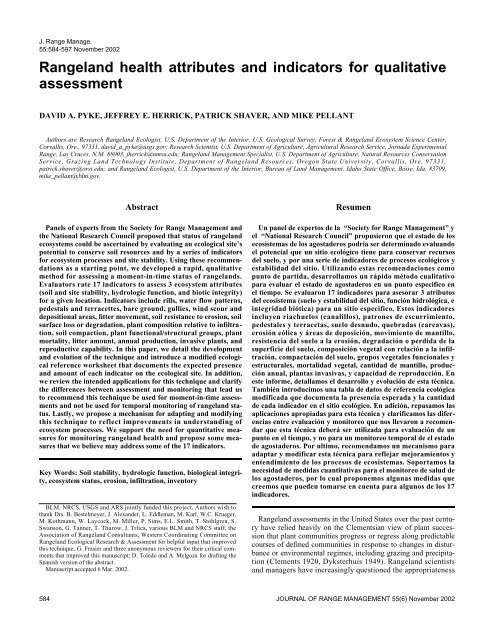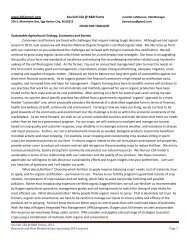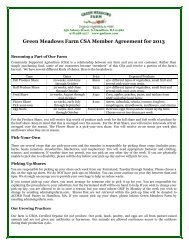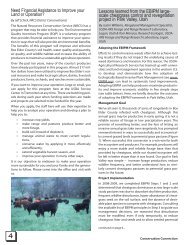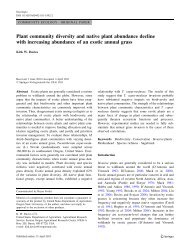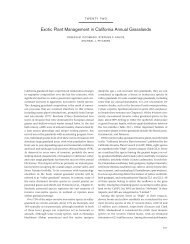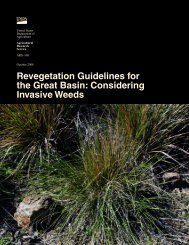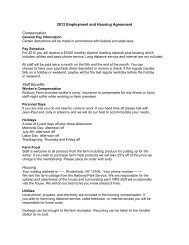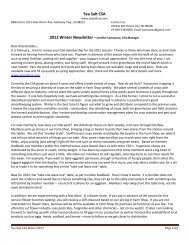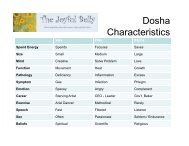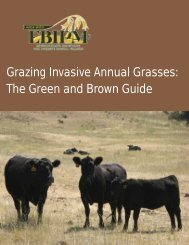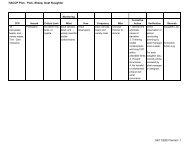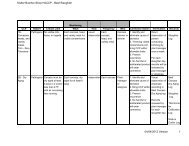Rangeland health attributes and indicators for qualitative assessment
Rangeland health attributes and indicators for qualitative assessment
Rangeland health attributes and indicators for qualitative assessment
Create successful ePaper yourself
Turn your PDF publications into a flip-book with our unique Google optimized e-Paper software.
J. Range Manage.<br />
55:584-597 November 2002<br />
<strong>Rangel<strong>and</strong></strong> <strong>health</strong> <strong>attributes</strong> <strong>and</strong> <strong>indicators</strong> <strong>for</strong> <strong>qualitative</strong><br />
<strong>assessment</strong><br />
DAVID A. PYKE, JEFFREY E. HERRICK, PATRICK SHAVER, AND MIKE PELLANT<br />
Authors are Research <strong>Rangel<strong>and</strong></strong> Ecologist, U.S. Department of the Interior, U.S. Geological Survey, Forest & <strong>Rangel<strong>and</strong></strong> Ecosystem Science Center,<br />
Corvallis, Ore., 97331, david_a_pyke@usgs.gov; Research Scientist, U.S. Department of Agriculture, Agricultural Research Service, Jornada Experimental<br />
Range, Las Cruces, N.M. 88003, jherrick@nmsu.edu; <strong>Rangel<strong>and</strong></strong> Management Specialist, U.S. Department of Agriculture, Natural Resources Conservation<br />
Service, Grazing L<strong>and</strong> Technology Institute, Department of <strong>Rangel<strong>and</strong></strong> Resources, Oregon State University, Corvallis, Ore. 97331,<br />
patrick.shaver@orst.edu; <strong>and</strong> <strong>Rangel<strong>and</strong></strong> Ecologist, U.S. Department of the Interior, Bureau of L<strong>and</strong> Management, Idaho State Office, Boise, Ida. 83709,<br />
mike_pellant@blm.gov.<br />
Abstract<br />
Panels of experts from the Society <strong>for</strong> Range Management <strong>and</strong><br />
the National Research Council proposed that status of rangel<strong>and</strong><br />
ecosystems could be ascertained by evaluating an ecological site’s<br />
potential to conserve soil resources <strong>and</strong> by a series of <strong>indicators</strong><br />
<strong>for</strong> ecosystem processes <strong>and</strong> site stability. Using these recommendations<br />
as a starting point, we developed a rapid, <strong>qualitative</strong><br />
method <strong>for</strong> assessing a moment-in-time status of rangel<strong>and</strong>s.<br />
Evaluators rate 17 <strong>indicators</strong> to assess 3 ecosystem <strong>attributes</strong><br />
(soil <strong>and</strong> site stability, hydrologic function, <strong>and</strong> biotic integrity)<br />
<strong>for</strong> a given location. Indicators include rills, water flow patterns,<br />
pedestals <strong>and</strong> terracettes, bare ground, gullies, wind scour <strong>and</strong><br />
depositional areas, litter movement, soil resistance to erosion, soil<br />
surface loss or degradation, plant composition relative to infiltration,<br />
soil compaction, plant functional/structural groups, plant<br />
mortality, litter amount, annual production, invasive plants, <strong>and</strong><br />
reproductive capability. In this paper, we detail the development<br />
<strong>and</strong> evolution of the technique <strong>and</strong> introduce a modified ecological<br />
reference worksheet that documents the expected presence<br />
<strong>and</strong> amount of each indicator on the ecological site. In addition,<br />
we review the intended applications <strong>for</strong> this technique <strong>and</strong> clarify<br />
the differences between <strong>assessment</strong> <strong>and</strong> monitoring that lead us<br />
to recommend this technique be used <strong>for</strong> moment-in-time <strong>assessment</strong>s<br />
<strong>and</strong> not be used <strong>for</strong> temporal monitoring of rangel<strong>and</strong> status.<br />
Lastly, we propose a mechanism <strong>for</strong> adapting <strong>and</strong> modifying<br />
this technique to reflect improvements in underst<strong>and</strong>ing of<br />
ecosystem processes. We support the need <strong>for</strong> quantitative measures<br />
<strong>for</strong> monitoring rangel<strong>and</strong> <strong>health</strong> <strong>and</strong> propose some measures<br />
that we believe may address some of the 17 <strong>indicators</strong>.<br />
Key Words: Soil stability, hydrologic function, biological integrity,<br />
ecosystem status, erosion, infiltration, inventory<br />
BLM, NRCS, USGS <strong>and</strong> ARS jointly funded this project. Authors wish to<br />
thank Drs. B. Bestelmeyer, J. Alex<strong>and</strong>er, L. Eddleman, M. Karl, W.C. Krueger,<br />
M. Kothmann, W. Laycock, M. Miller, P. Sims, E.L. Smith, T. Stohlgren, S.<br />
Swanson, G. Tanner, T. Thurow, J. Trlica, various BLM <strong>and</strong> NRCS staff, the<br />
Association of <strong>Rangel<strong>and</strong></strong> Consultants, Western Coordinating Committee on<br />
<strong>Rangel<strong>and</strong></strong> Ecological Research & Assessment <strong>for</strong> helpful input that improved<br />
this technique; G. Frasier <strong>and</strong> three anonymous reviewers <strong>for</strong> their critical comments<br />
that improved this manuscript; D. Toledo <strong>and</strong> A. Melgoza <strong>for</strong> drafting the<br />
Spanish version of the abstract.<br />
Manuscript accepted 6 Mar. 2002.<br />
Resumen<br />
Un panel de expertos de la “Society <strong>for</strong> Range Management” y<br />
el “National Research Council” propusieron que el estado de los<br />
ecosistemas de los agostaderos podría ser determinado evalu<strong>and</strong>o<br />
el potencial que un sitio ecológico tiene para conservar recursos<br />
del suelo, y por una serie de indicadores de procesos ecológicos y<br />
estabilidad del sitio. Utiliz<strong>and</strong>o estas recomendaciones como<br />
punto de partida, desarrollamos un rápido método cualitativo<br />
para evaluar el estado de agostaderos en un punto especifico en<br />
el tiempo. Se evaluaron 17 indicadores para asesorar 3 atributos<br />
del ecosistema (suelo y estabilidad del sitio, función hidrológica, e<br />
integridad biótica) para un sitio especifico. Estos indicadores<br />
incluyen riachuelos (canalillos), patrones de escurrimiento,<br />
pedestales y terracetas, suelo desnudo, quebradas (carcavas),<br />
erosión eólica y áreas de deposición, movimiento de mantillo,<br />
resistencia del suelo a la erosión, degradación o perdida de la<br />
superficie del suelo, composición vegetal con relación a la infiltración,<br />
compactación del suelo, grupos vegetales funcionales y<br />
estructurales, mortalidad vegetal, cantidad de mantillo, producción<br />
anual, plantas invasivas, y capacidad de reproducción. En<br />
este in<strong>for</strong>me, detallamos el desarrollo y evolución de esta técnica.<br />
También introducimos una tabla de datos de referencia ecológica<br />
modificada que documenta la presencia esperada y la cantidad<br />
de cada indicador en el sitio ecológico. En adición, repasamos las<br />
aplicaciones apropiadas para esta técnica y clarificamos las diferencias<br />
entre evaluación y monitoreo que nos llevaron a recomendar<br />
que esta técnica deberá ser utilizada para evaluación de un<br />
punto en el tiempo, y no para un monitoreo temporal de el estado<br />
de agostaderos. Por ultimo, recomendamos un mecanismo para<br />
adaptar y modificar esta técnica para reflejar mejoramientos y<br />
entendimiento de los procesos de ecosistemas. Soportamos la<br />
necesidad de medidas cuantitativas para el monitoreo de salud de<br />
los agostaderos, por lo cual proponemos algunas medidas que<br />
creemos que pueden tomarse en cuenta para algunos de los 17<br />
indicadores.<br />
<strong>Rangel<strong>and</strong></strong> <strong>assessment</strong>s in the United States over the past century<br />
have relied heavily on the Clementsian view of plant succession<br />
that plant communities progress or regress along predictable<br />
courses of defined communities in response to changes in disturbance<br />
or environmental regimes, including grazing <strong>and</strong> precipitation<br />
(Clements 1920, Dyksterhuis 1949). <strong>Rangel<strong>and</strong></strong> scientists<br />
<strong>and</strong> managers have increasingly questioned the appropriateness<br />
584 JOURNAL OF RANGE MANAGEMENT 55(6) November 2002
of this model <strong>for</strong> making 1 type of rangel<strong>and</strong><br />
<strong>assessment</strong>, rangel<strong>and</strong> condition<br />
(Westoby et al. 1989a, 1989b, Friedel<br />
1991, Laycock 1991, Svejcar <strong>and</strong> Brown<br />
1991). Two panels of experts, National<br />
Research Council (NRC 1994) <strong>and</strong> the<br />
Society <strong>for</strong> Range Management Task<br />
Group on Unity in Concepts <strong>and</strong><br />
Terminology Committee (SRM Task<br />
Group 1995), suggested alternative<br />
approaches <strong>for</strong> evaluating rangel<strong>and</strong> status<br />
that relied on factors other than the traditional<br />
rangel<strong>and</strong> condition classification<br />
<strong>and</strong> on similarity of plant species composition<br />
to a single climax community. The<br />
NRC (1994) experts advocated the evaluation<br />
of multiple <strong>indicators</strong> to assess a site’s<br />
degree of soil stability <strong>and</strong> watershed<br />
function, integrity of nutrient cycles <strong>and</strong><br />
energy flow, <strong>and</strong> presence of functioning<br />
recovery mechanisms. The SRM Task<br />
Group (1995) recommended that new<br />
<strong>assessment</strong>s focus primarily on the soil<br />
stability of a site. The Task Group recommended<br />
<strong>and</strong> the SRM adopted the following:<br />
(1) that evaluations of a site be based<br />
on the expected capability <strong>for</strong> that l<strong>and</strong><br />
unit (the ecological site) to support a natural<br />
range of potential plant communities;<br />
(2) that each potential plant community be<br />
evaluated <strong>for</strong> its ability to protect the site<br />
from accelerated erosion; <strong>and</strong> (3) that<br />
managers develop objectives <strong>for</strong> l<strong>and</strong> uses<br />
<strong>and</strong> manage the l<strong>and</strong> to achieve or maintain<br />
a desired plant community that protects<br />
the site against accelerated erosion.<br />
The U. S. Department of the Interior<br />
(USDI), Bureau of L<strong>and</strong> Management<br />
(BLM) <strong>and</strong> the U. S. Department of<br />
Agriculture (USDA), Natural Resources<br />
Conservation Service (NRCS) expressed a<br />
need <strong>for</strong> a rapid technique that provides an<br />
initial <strong>assessment</strong> of rangel<strong>and</strong> <strong>health</strong><br />
based on a workable set of criteria from a<br />
combination of the NRC (1994) <strong>and</strong> SRM<br />
Task Group (1995) reports. These agencies<br />
were not seeking a monitoring technique<br />
(as defined by SRM Glossary<br />
Update Task Group 1998) to determine if<br />
their management objectives had been met<br />
over time or if significant progress had<br />
been made toward meeting these objectives.<br />
Rather, they sought a moment-intime<br />
<strong>assessment</strong> that would be equally<br />
effective in estimating the status of most<br />
rangel<strong>and</strong> communities (i.e., from tropical<br />
grassl<strong>and</strong>s <strong>and</strong> coastal marshes to desert<br />
<strong>and</strong> tundra ecosystems) within the United<br />
States.<br />
We address 4 objectives in this paper.<br />
First, we provide an overview of a technique<br />
that satisfies the NRCS/BLM criteria<br />
(Pellant et al. 2000). Second, we<br />
describe the approach used to develop this<br />
technique <strong>and</strong> introduce an improved technique<br />
<strong>for</strong> developing reference conditions<br />
<strong>for</strong> ecological sites. Third, we define the<br />
intended applications of the technique <strong>and</strong><br />
explain the why we believe this technique<br />
may be used to provide a moment-in-time<br />
<strong>assessment</strong> of rangel<strong>and</strong> <strong>health</strong>, but not to<br />
temporally monitor rangel<strong>and</strong>s. Fourth, we<br />
describe a mechanism <strong>for</strong> adapting the<br />
technique <strong>for</strong> different ecosystems <strong>and</strong> <strong>for</strong><br />
ensuring that the technique will continue<br />
to reflect improvements in underst<strong>and</strong>ing<br />
of ecosystem processes.<br />
<strong>Rangel<strong>and</strong></strong> Health<br />
We have chosen to use a definition of<br />
rangel<strong>and</strong> <strong>health</strong> developed by an ad hoc<br />
interagency committee (USDA, NRCS<br />
1997). <strong>Rangel<strong>and</strong></strong> <strong>health</strong> is the degree to<br />
which the integrity of the soil, vegetation,<br />
water <strong>and</strong> air as well as the ecological<br />
processes of the rangel<strong>and</strong> ecosystem are<br />
balanced <strong>and</strong> sustained. Integrity is<br />
defined as the maintenance of the functional<br />
<strong>attributes</strong> characteristic of a locale,<br />
including normal variability. Although<br />
there are a number of problems associated<br />
with applying the term “<strong>health</strong> “ to natural<br />
ecosystems (Wicklum <strong>and</strong> Davies 1995,<br />
Lackey 1998, Rapport et al. 1998, Smith<br />
1999), we elected to retain it. The NRC<br />
(1994) report used the term in the title of<br />
its publication. Concurrently, the public<br />
has begun to accept this term <strong>and</strong> to associate<br />
it with the status of ecological systems.<br />
With <strong>Rangel<strong>and</strong></strong> Re<strong>for</strong>m in 1994,<br />
the BLM began developing st<strong>and</strong>ards <strong>for</strong><br />
rangel<strong>and</strong> <strong>health</strong> <strong>and</strong> guidelines <strong>for</strong> livestock<br />
grazing management on BLM rangel<strong>and</strong>s<br />
with the assistance of Resource<br />
Advisory Councils (USDI, BLM 1994).<br />
Although these st<strong>and</strong>ards <strong>and</strong> guidelines<br />
differ <strong>for</strong> each state, they all incorporate<br />
language that relates to ecosystem <strong>health</strong><br />
<strong>and</strong> have become the BLM policy <strong>for</strong><br />
assessing public l<strong>and</strong> <strong>health</strong> <strong>and</strong> <strong>for</strong><br />
obtaining or maintaining ecological structure<br />
<strong>and</strong> function on BLM-managed l<strong>and</strong>s<br />
(USDI, BLM 2001). Similarly, the NRCS<br />
has incorporated the term rangel<strong>and</strong> <strong>health</strong><br />
into their latest addition of the National<br />
Range <strong>and</strong> Pasture H<strong>and</strong>book <strong>and</strong> into the<br />
inventory phase of the conservation planning<br />
process that they conduct with private<br />
l<strong>and</strong>owners (USDA, NRCS 1997). By<br />
retaining <strong>and</strong> defining rangel<strong>and</strong> <strong>health</strong>,<br />
we maintain a connection to the NRC<br />
report, to BLM’s st<strong>and</strong>ards <strong>and</strong> guidelines<br />
<strong>for</strong> managing rangel<strong>and</strong>s, <strong>and</strong> to NRCS<br />
National Range <strong>and</strong> Pasture H<strong>and</strong>book.<br />
Historical Development<br />
Background. In the mid 1990’s, several<br />
groups simultaneously advocated that all<br />
U.S. governmental agencies with responsibility<br />
<strong>for</strong> managing or reporting rangel<strong>and</strong><br />
status should coordinate a national <strong>assessment</strong><br />
of rangel<strong>and</strong>s using common techniques<br />
<strong>and</strong> designs (West et al. 1994, NRC<br />
1994, SRM Task Group 1995). Two of<br />
these reports (NRC 1994, SRM Task<br />
Group 1995) recommended the development<br />
of quantitative techniques <strong>for</strong> assessing<br />
ecosystem status, but both also noted<br />
that researchers would need to develop<br />
new <strong>and</strong> efficient techniques to measure<br />
many <strong>indicators</strong> of ecosystem status.<br />
The NRC (1994) <strong>and</strong> SRM Task Group<br />
(1995) also recommended that <strong>assessment</strong>s<br />
be used to classify <strong>and</strong> compare<br />
similar combinations of soils <strong>and</strong> climate<br />
that have the capacity to support ecosystems<br />
with similar plant communities <strong>and</strong><br />
production (e.g., ecological sites). New<br />
ecological site descriptions (USDA,<br />
NRCS 1997), which are in the process of<br />
being developed, recognize <strong>and</strong> portray<br />
the multiplicity of vegetation states <strong>and</strong><br />
transitions among states that are expected<br />
with natural or human-induced changes<br />
(Westoby et al. 1989a, 1989b, Stringham<br />
et al. 2001). These descriptions also use<br />
the threshold concept to describe unidirectional<br />
changes in ecosystem structure <strong>and</strong><br />
ecosystem functional processes. When<br />
these thresholds are crossed, recovery to<br />
original ecosystem states is difficult<br />
(Laycock 1991, Friedel 1991, SRM Task<br />
Group 1995). When possible, ecosystem<br />
<strong>assessment</strong>s should strive to incorporate<br />
these concepts as research results refine<br />
our underst<strong>and</strong>ing of states, transitions <strong>and</strong><br />
thresholds.<br />
In 1997, agency leaders <strong>for</strong> the BLM,<br />
NRCS, <strong>and</strong> the USDA Forest Service<br />
signed a Memor<strong>and</strong>um of Underst<strong>and</strong>ing<br />
(interagency MOU group) that <strong>for</strong>med a<br />
committee responsible <strong>for</strong> overseeing the<br />
development of a common national rangel<strong>and</strong><br />
<strong>assessment</strong> technique. This committee<br />
is pursuing the development of quantitative<br />
<strong>assessment</strong> <strong>indicators</strong> <strong>and</strong> protocols.<br />
While quantitative national <strong>assessment</strong><br />
techniques are being developed, the BLM<br />
<strong>and</strong> NRCS identified a need <strong>for</strong> a rapid<br />
<strong>assessment</strong> technique that could provide a<br />
preliminary <strong>assessment</strong> of rangel<strong>and</strong><br />
<strong>health</strong> at the management unit or lower<br />
level. Additionally, the technique could<br />
provide a communication tool with stakeholders<br />
regarding the status of ecosystem<br />
properties <strong>and</strong> processes.<br />
JOURNAL OF RANGE MANAGEMENT55(6) November<br />
585
Approach used to develop the tech -<br />
nique. In 1995, the NRCS <strong>and</strong> BLM<br />
began development of <strong>qualitative</strong> techniques<br />
<strong>for</strong> the <strong>assessment</strong> of rangel<strong>and</strong><br />
<strong>health</strong> using the NRC (1994) <strong>and</strong> SRM<br />
Task Group (1995) recommendations as a<br />
starting point. These ef<strong>for</strong>ts resulted in the<br />
development of 2 similar protocols. The<br />
first 2 versions of this technique were<br />
developed separately by the BLM (Pellant<br />
1996) <strong>and</strong> NRCS (USDA, NRCS 1997).<br />
These versions were similar, but not identical.<br />
In 1997, we integrated these versions<br />
<strong>and</strong> began a coordinated ef<strong>for</strong>t to evaluate<br />
each indicator based on the scientific literature<br />
<strong>and</strong> field tests in rangel<strong>and</strong> ecosystems<br />
throughout the United States.<br />
Indicators that were not supported by the<br />
literature, that could not be consistently<br />
applied or interpreted, or that were not<br />
sensitive to changes in ecosystem structure<br />
or function across a wide variety of<br />
ecosystems, were modified, replaced or<br />
discarded. For example, repeatability<br />
among observers varied using the BLM<br />
version that contained only 3 rating categories<br />
(properly functioning, functioning<br />
at risk, <strong>and</strong> non-functioning) <strong>for</strong> 18 <strong>indicators</strong><br />
divided among a biotic <strong>and</strong> a physical<br />
attribute (Rasmussen et al. 1999). In<br />
response, we adjusted the rating categories<br />
to 5, the level used in the NRCS version of<br />
the technique.<br />
This iterative process involved approximately<br />
500 people participating in over 16<br />
training or testing sessions in 10 states<br />
covering 9 of the 36 ecosystem provinces<br />
of the humid, temperate <strong>and</strong> dry domains<br />
in the 48 contiguous states in the United<br />
States (Bailey et al. 1994). Participants<br />
included scientists (federal <strong>and</strong> university),<br />
federal, state, <strong>and</strong> tribal l<strong>and</strong> managers,<br />
ranchers <strong>and</strong> members of conservation<br />
organizations. Over 20 scientists, 25<br />
BLM <strong>and</strong> NRCS resource specialists, 35<br />
consultants from the Association of<br />
<strong>Rangel<strong>and</strong></strong> Consultants, <strong>and</strong> members of<br />
the Western Coordinating Committee on<br />
<strong>Rangel<strong>and</strong></strong> Ecological Research <strong>and</strong><br />
Assessment (WCC-40) reviewed <strong>and</strong> criticized<br />
the final draft of the technique. The<br />
technique <strong>and</strong> the document (Pellant et al.<br />
2000) were improved by incorporating<br />
modifications suggested by these peers.<br />
For example, training participants found it<br />
difficult to provide a single <strong>assessment</strong> of<br />
rangel<strong>and</strong> <strong>health</strong> <strong>for</strong> an evaluation area<br />
<strong>and</strong> that they wanted to be able to generate<br />
in<strong>for</strong>mation relevant to specific <strong>attributes</strong>.<br />
In response, we modified the technique to<br />
provide separate ratings <strong>for</strong> each of the 3<br />
<strong>attributes</strong> <strong>and</strong> to eliminate any reference to<br />
a single rating of overall status.<br />
Description of the Technique<br />
(Methods)<br />
Overview. The technique involves evaluating<br />
all locations using the same minimum<br />
set of 17 <strong>qualitative</strong> <strong>indicators</strong> relative<br />
to their potential within an ecological<br />
site. We use the Society <strong>for</strong> Range<br />
Management (SRM Glossary Update Task<br />
Group 1998) definition of an ecological<br />
site being “a kind of l<strong>and</strong> with specific<br />
physical characteristics which differs from<br />
other kinds of l<strong>and</strong> in its ability to produce<br />
distinctive kinds <strong>and</strong> amounts of vegetation<br />
<strong>and</strong> in its response to management.”<br />
Site potential <strong>for</strong> each indicator is defined<br />
by that indicator’s presence <strong>and</strong> range of<br />
amount in resistant <strong>and</strong> resilient plant<br />
community phases that maximize retention<br />
of soil. These may be determined by<br />
examining a range of reference areas that<br />
describe these phases or they may be<br />
defined in or inferred from the ecological<br />
site description. Ecological site descriptions<br />
describe soil associations (as defined<br />
by the Soil Science Society of America<br />
1997) <strong>and</strong> their physical, hydrological <strong>and</strong><br />
biological characteristics that produce distinctive<br />
kinds <strong>and</strong> amounts of vegetation.<br />
The amount of in<strong>for</strong>mation included in<br />
ecological site descriptions varies depending<br />
on when the description was written.<br />
Early descriptions, originally called range<br />
site descriptions, contained basic descriptions<br />
of soils <strong>and</strong> vegetation. Ecological<br />
site descriptions written or revised since<br />
1997 contain additional detail on the variation<br />
in plant composition, cover <strong>and</strong> production<br />
<strong>for</strong> the dynamic set of vegetation<br />
states <strong>and</strong> on hydrologic <strong>and</strong> soil stability<br />
characteristics of the ecological site. The<br />
NRCS has committed to a program of<br />
revising all previously written range site<br />
<strong>and</strong> ecological site descriptions into this<br />
new <strong>for</strong>mat (Pers. Comm. G. Peacock,<br />
NRCS Grazing L<strong>and</strong>s Technology<br />
Institute, Fort Worth Tex.). All currently<br />
approved ecological site descriptions are<br />
available at local NRCS offices. In addition,<br />
they will be available on the Internet<br />
at the PLANTS database homepage<br />
(USDA, NRCS 2001) under the<br />
Ecological Site In<strong>for</strong>mation System<br />
(ESIS) heading. If neither reference areas<br />
nor an ecological site description exist,<br />
then a group of soil <strong>and</strong> plant experts<br />
should define <strong>and</strong> document their expectations<br />
<strong>for</strong> each of these <strong>indicators</strong> using<br />
their knowledge <strong>and</strong> data about similar<br />
soils <strong>and</strong> plant communities.<br />
Three overlapping subsets of <strong>indicators</strong><br />
are used to assess 3 <strong>attributes</strong> of the site:<br />
soil <strong>and</strong> site stability, hydrologic function,<br />
<strong>and</strong> biotic integrity. We use the term<br />
attribute to describe an ecosystem component<br />
that cannot be directly measured, but<br />
can be approximated by a set of observable<br />
<strong>indicators</strong> of the component. The<br />
<strong>assessment</strong> of these 3 <strong>attributes</strong> is the final<br />
product of the technique. In the remainder<br />
of this section, we describe <strong>attributes</strong> <strong>and</strong><br />
<strong>indicators</strong>, outline the technique that is<br />
used to evaluate each indicator relative to<br />
its potential <strong>for</strong> a particular site. We<br />
include a new method <strong>for</strong> documenting<br />
reference conditions <strong>for</strong> each indicator <strong>and</strong><br />
define how the 3 <strong>attributes</strong> are evaluated<br />
based on a combination of <strong>indicators</strong> to<br />
arrive at an <strong>assessment</strong> of the status of<br />
each attribute.<br />
Attributes. Both the SRM Task Group<br />
(1995) <strong>and</strong> the NRC (1994) reports suggested<br />
a single rating <strong>for</strong> the site <strong>assessment</strong>.<br />
The SRM Task Group (1995)<br />
emphasized soil conservation in their<br />
hypothetical quantitative approach. They<br />
proposed the development of a Site<br />
Conservation Rating (SCR), “an <strong>assessment</strong><br />
of the protection af<strong>for</strong>ded a site by<br />
the current vegetation against loss of<br />
potential.” They also proposed that a Site<br />
Conservation Threshold (SCT), “the kind,<br />
amount, <strong>and</strong>/or pattern of vegetation needed<br />
as a minimum on a given site to prevent<br />
accelerated erosion,” would provide a<br />
mechanism <strong>for</strong> categorizing a site as “satisfactory<br />
or sustainable” or “unsatisfactory<br />
or unsustainable.” Although this Task<br />
Group proposed this new approach <strong>for</strong><br />
evaluating l<strong>and</strong>s, they clearly stated that<br />
criteria <strong>for</strong> evaluating the SCR <strong>and</strong> SCT<br />
should be objective <strong>and</strong> quantitative<br />
enough to serve as monitoring parameters<br />
<strong>for</strong> assessing the trend in the SCR.<br />
However, these criteria “will have to be<br />
worked out by research <strong>and</strong> professional<br />
judgment <strong>for</strong> each ecological site” (SRM<br />
Task Group 1995). To our knowledge, few<br />
studies have attempted to develop or test<br />
quantitative criteria <strong>for</strong> a SCR (Watters et<br />
al. 1996) whereas some development has<br />
begun <strong>for</strong> some <strong>indicators</strong> of <strong>for</strong>est <strong>and</strong><br />
rangel<strong>and</strong> <strong>health</strong> or sustainability (de<br />
Soyza et al. 1997, 2000, Weltz et al. 2000,<br />
Woodley et al. 2000, Herrick et al. 2002).<br />
The NRC (1994) suggested classifying<br />
l<strong>and</strong>s into 3 categories using soil <strong>and</strong> ecological<br />
processes as basic elements of site<br />
production: (1) those l<strong>and</strong>s that remain<br />
above an early warning line where the<br />
l<strong>and</strong> produces at its potential <strong>for</strong> commodities<br />
<strong>and</strong> other values; (2) those that<br />
fall below this early warning line <strong>and</strong> have<br />
a reduced ability to produce commodities<br />
<strong>and</strong> support other values, but where this<br />
reduction can be reversed through man-<br />
586 JOURNAL OF RANGE MANAGEMENT 55(6) November 2002
Table 1. St<strong>and</strong>ard <strong>indicators</strong> included in the rangel<strong>and</strong> <strong>health</strong> protocol, <strong>attributes</strong> to which each indicator applies, <strong>and</strong> publications used to develop the<br />
descriptors <strong>and</strong> interpretations <strong>for</strong> each indicator.<br />
Indicators <strong>and</strong> brief descriptions of characteristics <strong>for</strong> Attributes Relevant Literature<br />
evaluating the indicator Soil <strong>and</strong> Hydrologic Biotic<br />
Site Function Integrity<br />
Stability<br />
1. Rills – the frequency <strong>and</strong> spatial distribution of linear X X Quansah 1985, Morgan <strong>and</strong> Davidson 1986, Bryan 1987<br />
erosional rivulets.<br />
2. Water Flow Patterns – the amount <strong>and</strong> distribution of X X Morgan <strong>and</strong> Davidson 1986, Tiscareño Lopez et al. 1993<br />
overl<strong>and</strong> flow paths that are identified by litter distribution<br />
<strong>and</strong> visual evidence of soil <strong>and</strong> gravel movement.<br />
3. Pedestals <strong>and</strong>/or Terracettes – the frequency <strong>and</strong> X X Anderson 1974, Morgan <strong>and</strong> Davidson 1986, Satterlund<br />
distribution of rocks or plants where soil has been eroded <strong>and</strong> Adams 1992, Hudson 1993<br />
from their base (pedestals) or areas of soil deposition<br />
behind obstacles.<br />
4. Bare Ground – size <strong>and</strong> connectivity among areas of soil X X Smith <strong>and</strong> Wischmeier 1962, Anderson 1974, Gould<br />
not protected by vegetation, biological soil crusts, litter, 1982, Morgan <strong>and</strong> Davidson 1986, Benkobi et al. 1993,<br />
st<strong>and</strong>ing dead vegetation, gravel or rocks. Blackburn <strong>and</strong> Pierson 1994, Pierson et al. 1994,<br />
Spaeth et al. 1994, Gutierrez <strong>and</strong> Hern<strong>and</strong>ez 1996,<br />
Puigdefábregas <strong>and</strong> Sánchez 1996, Weltz et al. 1998,<br />
Cerda 1999<br />
5. Gullies –amount of channels cut into the soil <strong>and</strong> the X X Anderson 1974, Morgan <strong>and</strong> Davidson 1986,<br />
amount <strong>and</strong> distribution of vegetation in the channel. Martin <strong>and</strong> Morton 1993<br />
6. Wind Scoured, Blowouts <strong>and</strong>/or Deposition Areas – X Chepil 1945, Chepil <strong>and</strong> Woodruff 1963, Anderson 1974,<br />
frequency of areas where soil is removed from under<br />
Gillette et al. 1974, Gillette <strong>and</strong> Walker 1977, Gibbens et<br />
physical or biological soil crust or around vegetation<br />
al. 1983, Hennessy et al. 1983, Hagen 1984, Hennessy et<br />
OR frequency of accumulation areas of soil associated al. 1986, Morgan <strong>and</strong> Davidson 1986, Pye 1987<br />
with large structural objects, often woody plants.<br />
7. Litter Movement – frequency <strong>and</strong> size of displaced litter X Thurow et al. 1988<br />
by wind <strong>and</strong> overl<strong>and</strong> flow of water.<br />
8. Soil Surface Resistance to Erosion – ability of soils to resist X X X Bond <strong>and</strong> Harris 1964, Belnap <strong>and</strong> Gardner 1993,<br />
erosion through the incorporation of organic material into soil Blackburn et al. 1992, Morgan <strong>and</strong> Davidson 1986,<br />
aggregates. It is evaluated by using a modified slake test.<br />
Goff et al. 1993, Blackburn <strong>and</strong> Pierson 1994, Fryrear et<br />
al. 1994, Pierson et al. 1994, Morgan et al. 1997,<br />
Belnap <strong>and</strong> Gillette 1998, Herrick et al. 2001<br />
9. Soil Surface Loss or Degradation – frequency <strong>and</strong> size of X X X Hennessy et al. 1986, Warren et al. 1986, Satterlund <strong>and</strong><br />
areas missing all or portions of the upper soil horizons that Adams 1992, O’Hara et al. 1993, Karlen <strong>and</strong> Stott 1994,<br />
normally contain the majority of organic material of the site.<br />
Wood et al. 1997, Davenport et al. 1998, Dormaar <strong>and</strong><br />
Willms 1998<br />
10. Plant Community Composition & Distribution Relative to X Blackburn 1975, Wood <strong>and</strong> Blackburn 1984,<br />
Infiltration & Runoff – the community composition or Johnson <strong>and</strong> Gordon 1988, Thurow et al. 1988,<br />
distribution of species that restrict the infiltration of water Blackburn <strong>and</strong> Wood 1990, Schlesinger et al. 1990,<br />
on the site. Blackburn et al. 1992<br />
11. Compaction Layer – thickness <strong>and</strong> distribution of the X X X Barnes et al. 1971, Webb <strong>and</strong> Wilshire 1983, Willat <strong>and</strong><br />
structure of the soil near the soil surface (=< 15 cm) Pullar 1983, Cole 1985, Blake <strong>and</strong> Hartge 1986,<br />
Warren et al. 1986, Wallace 1987, Thurow et al. 1988,<br />
Hassink et al. 1993, Larson <strong>and</strong> Pierce 1993, Chanasyk<br />
<strong>and</strong> Naeth 1995, Hillel 1998<br />
12. Functional/Structural Groups – the number of groups, X Chapin 1993, Dawson <strong>and</strong> Chapin 1993, Solbrig et al.<br />
the number of species within groups, or the rank of order 1996, Tilman et al. 1997<br />
of dominance of groups.<br />
13. Plant Mortality/Decadence – frequency of dead or X Stoddard et al. 1975, Pyke 1995,<br />
moribund (dying) plants<br />
14. Litter Amount – deviation in the amount of litter. X X Thurow et al. 1988, Whit<strong>for</strong>d 1988, Whit<strong>for</strong>d 1996,<br />
Hester et al. 1997<br />
15. Annual Abroveground Production – amount relative X Cooper 1975, Whittaker 1975, Rickard <strong>and</strong> Rogers 1988,<br />
to the potential <strong>for</strong> that year based upon the climate. Tilman <strong>and</strong> Downing 1994<br />
16. Invasive Plants – abundance <strong>and</strong> distribution of X Lacey et al. 1990, Olson 1999, Stohlgren et al. 1999<br />
invasive plants regardless if they are noxious weeds,<br />
exotic species, or native plants whose dominance greatly<br />
exceeds that expected at the ecological site.<br />
17. Reproductive Capability of Perennial Plants – evidence X Hanson <strong>and</strong> Stoddard 1940, Mueggler 1975, Harper 1977,<br />
of the inflorescences or of vegetative tiller production White 1979<br />
relative to the potential based upon the current climate.<br />
JOURNAL OF RANGE MANAGEMENT 55(6) November<br />
587
Table 2. The 6 steps of the Interpreting Indicators of <strong>Rangel<strong>and</strong></strong> Health (Pellant et al. 2000) are<br />
summarized along with the location (evaluation or reference area) where the step is completed,<br />
<strong>and</strong> the recommended worksheets (found in Pellant et al. 2000) that are used when completing<br />
each step.<br />
Step Description Location Recommended worksheets<br />
1 Identify the evaluation area Evaluation Area 1. <strong>Rangel<strong>and</strong></strong> Health<br />
<strong>and</strong> verify soils <strong>and</strong> ecological Evaluation Summary, Part 1<br />
site <strong>for</strong> the area<br />
2 Develop expected indicator In the office <strong>and</strong> 1. New Ecological Reference<br />
ranges <strong>for</strong> the ecological site. at the Ecological Worksheet (Table 3)<br />
Visually familiarize yourself Reference Area 2. Cover<br />
with the 17 <strong>indicators</strong> at an<br />
3. Species Dominance<br />
Ecological Reference Area <strong>and</strong><br />
4. Functional/Structural<br />
rate the reference area against<br />
Groups (Potential<br />
the Ecological Reference<br />
Dominance)<br />
Worksheet<br />
3 Review or modify descriptors of Ecological 1. <strong>Rangel<strong>and</strong></strong> Health Indicator<br />
<strong>indicators</strong> Reference Area Evaluation Matrix (Table 4)<br />
4 Characterize the vegetation<br />
found at the evaluation area Evaluation Area 1. Cover<br />
2. Species Dominance<br />
3. Functional/Structural Groups<br />
(Actual Dominance)<br />
5 Rate the 17 <strong>indicators</strong> Evaluation Area 1. <strong>Rangel<strong>and</strong></strong> Health Evaluation<br />
Summary, Part 2 (Table 5)<br />
2. Use <strong>Rangel<strong>and</strong></strong> Health<br />
Indicator Evaluation Matrix<br />
(Table 4)<br />
6 Determine functional status of Evaluation Area 1. <strong>Rangel<strong>and</strong></strong> Health Evaluation<br />
the rangel<strong>and</strong> <strong>health</strong> <strong>attributes</strong> Summary, Part 3 (Table 6)<br />
agement changes; <strong>and</strong> (3) those sites with<br />
substantial reductions in commodities <strong>and</strong><br />
values where management changes are not<br />
likely to reverse this reduction. They proposed<br />
that criteria <strong>for</strong> rangel<strong>and</strong> <strong>health</strong> be<br />
defined using multiple <strong>indicators</strong> in 3<br />
major areas: (1) soil stability <strong>and</strong> watershed<br />
function; (2) the integrity of nutrient<br />
cycles <strong>and</strong> energy flow; <strong>and</strong> (3) the presence<br />
of functioning recovery mechanisms.<br />
Although they proposed these criteria, they<br />
recognized the lack of quantitative procedures<br />
that could be used efficiently <strong>and</strong><br />
economically in <strong>assessment</strong>s of large<br />
amounts of rangel<strong>and</strong>s. They advocated the<br />
need <strong>for</strong> research to develop such quantitative<br />
approaches, but in lieu of such techniques,<br />
they suggested a series of <strong>indicators</strong><br />
that could be <strong>qualitative</strong>ly evaluated.<br />
Although a single rating of a site’s status<br />
is intuitively appealing, we discovered<br />
early in the development process of this<br />
current approach that some sites might<br />
have <strong>attributes</strong> of ecosystem status that<br />
were operating properly while other <strong>attributes</strong><br />
were not. Initially, we began to look<br />
<strong>for</strong> <strong>indicators</strong> of nutrient cycling, energy<br />
flow <strong>and</strong> recovery mechanisms that<br />
observers could evaluate, but direct linkages<br />
between observable quantitative or<br />
<strong>qualitative</strong> measures of these processes<br />
were not easy to determine. By blending<br />
the NRC <strong>and</strong> the SRM Task Group<br />
approaches <strong>and</strong> by using an iterative<br />
process of field tests <strong>and</strong> peer reviews by<br />
l<strong>and</strong> managers <strong>and</strong> scientists, we identified<br />
3 <strong>attributes</strong> of ecosystem status that can be<br />
evaluated using multiple <strong>indicators</strong>:<br />
Soil or Site Stability – The capacity<br />
of the site to limit redistribution <strong>and</strong><br />
loss of soil resources (including nutrients<br />
<strong>and</strong> organic matter) by wind or<br />
water;<br />
Hydrologic Function – The capacity<br />
of the site to capture, store <strong>and</strong> safely<br />
release water from rainfall, run-on <strong>and</strong><br />
snowmelt (where relevant), to resist a<br />
reduction in this capacity <strong>and</strong> to recover<br />
this capacity following degradation;<br />
Integrity of the Biotic Community –<br />
The capacity of the site to support<br />
characteristic functional <strong>and</strong> structural<br />
communities in the context of normal<br />
variability <strong>and</strong> to resist loss of this<br />
function <strong>and</strong> structure caused by disturbance,<br />
<strong>and</strong> to recover following<br />
each disturbance.<br />
Indicators. We have selected <strong>indicators</strong><br />
to represent components of <strong>attributes</strong> that<br />
are difficult to measure directly. This use<br />
of <strong>indicators</strong> is similar to the approach<br />
used by others in selecting <strong>for</strong>est or rangel<strong>and</strong><br />
<strong>indicators</strong> (Breckenridge et al. 1995,<br />
de Soyza et al. 1997, 2000, Whit<strong>for</strong>d et al.<br />
1998, Woodley et al. 2000). We define<br />
<strong>indicators</strong> as observable components of an<br />
ecosystem that are related to 1 or more<br />
<strong>attributes</strong>, are easily evaluated, <strong>and</strong> used in<br />
combination with other <strong>indicators</strong> as an<br />
index of the status of that attribute. Each<br />
indicator at an evaluation area is assigned<br />
to 1 of 5 categories based on its departure<br />
from what is expected <strong>for</strong> that ecological<br />
site. The expectation <strong>for</strong> the ecological site<br />
should be derived from the soil survey, the<br />
ecological site description or, as a last<br />
resort, from expert opinion. Evaluators<br />
rate a site using 5 categories that describe<br />
a gradient <strong>for</strong> each indicator associated<br />
with each attribute. Indicators were selected<br />
if we could provide affirmative answers<br />
to 2 successive questions. (1) Did peerreviewed<br />
literature exist to support the<br />
association of this indicator with its<br />
attribute (2) Could experienced l<strong>and</strong><br />
managers underst<strong>and</strong> <strong>and</strong> consistently provide<br />
a visual <strong>assessment</strong> of this indicator<br />
Currently, we have included 17 <strong>indicators</strong><br />
<strong>for</strong> rating the 3 <strong>attributes</strong> (Table 1).<br />
Additional in<strong>for</strong>mation on the scientific<br />
basis <strong>for</strong> each indicator is included in an<br />
interagency technical reference (Pellant et<br />
al. 2000). Indicators can be associated<br />
with single <strong>attributes</strong>, such as litter movement’s<br />
association with hydrologic function<br />
<strong>and</strong> invasive plants’ association with<br />
biological integrity. Other <strong>indicators</strong> are<br />
associated with 2 or all 3 <strong>attributes</strong> (Table<br />
1). We recognize that some of these <strong>indicators</strong><br />
might be related to additional <strong>attributes</strong>,<br />
but we believe the associations that<br />
we have selected are the strongest or the<br />
best supported by the literature.<br />
Procedure. To rate the 3 <strong>attributes</strong> at an<br />
evaluation area, an evaluator must complete<br />
a 6-step process (Pellant et al. 2000,<br />
Table 2). Step 1 requires that evaluators<br />
visit an evaluation area to verify the soil<br />
<strong>and</strong> the ecological site of the area.<br />
Evaluation areas may be specific sites of<br />
concern within a management unit (e.g., a<br />
pasture, watershed, allotment or management<br />
area) or they may be a representative<br />
subsample of strata within a larger management<br />
unit (see Intended Applications).<br />
Evaluation areas should be within a specific<br />
l<strong>and</strong>scape position, include the natural<br />
variability of the ecological site, but<br />
remain sufficiently small (approximately<br />
0.4 to 2.0 ha or 1 to 5 ac), so that evaluators<br />
can easily walk throughout the area<br />
<strong>and</strong> observe the variation in the plant<br />
species composition <strong>and</strong> soil surface features.<br />
Since <strong>assessment</strong>s will be made relative<br />
to the ecological site description or<br />
ecological reference areas on the same<br />
ecological site, evaluators must be certain<br />
of the evaluation area’s l<strong>and</strong>scape position<br />
<strong>and</strong> soils (same ecological site). The eco-<br />
588 JOURNAL OF RANGE MANAGEMENT 55(6) November 2002
Table 3. Example of an Ecological Reference Worksheet developed <strong>for</strong> the Limy Ecological Site Description (italics) in the Southern Desert 4 subarea<br />
of Southern Desertic Basins, Plains <strong>and</strong> Mountains Major L<strong>and</strong> Resource Area (MLRA 42) in New Mexico. This example is based on the Natural<br />
Resources Conservation Service Ecological Site Description, unpublished data, <strong>and</strong> collective knowledge of J. Christensen, B. Call, B. Bestelmeyer,<br />
R. Placker, D. Trujillo, L. Hauser, D. Coalson, P. Smith, <strong>and</strong> J. Herrick.<br />
Indicators. For each indicator, describe the potential <strong>for</strong> the site. Where possible, (1) use numbers, (2) include expected range of values <strong>for</strong> poor-good years,<br />
when appropriate & (3) cite data. Continue descriptions on separate sheet.<br />
1. Number <strong>and</strong> extent of rills: None.<br />
2. Presence of water flow patterns: None, except following extremely high intensity storms, when short (less than 1 m) flow patterns may appear.<br />
3. Number <strong>and</strong> height of erosional pedestals or terracettes: None.<br />
4. Bare ground from Ecological Site Description or other studies (rock, litter, lichen, moss, plant canopy are not bare ground): 20 – 30 % bare ground;<br />
bare patches should be less than 8-10 inch diameter; occasional 12 inch patches associated with shrubs. Larger bare patches also associated with ant<br />
mounds <strong>and</strong> rodent disturbances.<br />
5. Number of gullies <strong>and</strong> erosion associated with gullies: None.<br />
6. Extent of wind scoured, blowouts <strong>and</strong>/or depositional areas: None.<br />
7. Amount of litter movement (describe size <strong>and</strong> distance expected to travel): Minimal <strong>and</strong> short, associated with water flow patterns following extremely<br />
high intensity storms. Litter also may be moved during intense wind storms.<br />
8. Soil surface (top few mm) resistance to erosion (stability values are averages – most sites will show a range of values): Stability class (Herrick et al.<br />
2001) anticipated to be 5-6 at surface <strong>and</strong> subsurface under vegetation <strong>and</strong> 4-5 at surface <strong>and</strong> subsurface in the interspaces. These values need verification<br />
at reference sites.<br />
9. Soil surface structure <strong>and</strong> SOM content (include type <strong>and</strong> strength of structure, <strong>and</strong> A-horizon color <strong>and</strong> thickness): 2-4 inch dark brown A horizon<br />
with medium granular structure (Otero County Armesa series description refers to platy structure; probably not from a true reference site).<br />
10. Effect of plant community composition (relative proportion of different functional groups) & spatial distribution on infiltration & runoff: High<br />
grass canopy <strong>and</strong> basal cover <strong>and</strong> small gaps between plants should reduce raindrop impact <strong>and</strong> slow overl<strong>and</strong> flow, providing increased time <strong>for</strong> infiltra -<br />
tion to occur. High root density of blue grama can limit infiltration. The more herbaceous vegetation on this site will result in less rain necessary to sustain<br />
this site because more water is retained.<br />
11. Presence <strong>and</strong> thickness of compaction layer (usually none; describe soil profile features which may be mistaken <strong>for</strong> compaction on this site): None<br />
12. Functional/Structural Groups (list in order of descending dominance by above-ground weight using symbols: >>, >, = to indicate much greater<br />
than, greater than, <strong>and</strong> equal to): Blue grama > Black grama > warm season bunchgrasses > Yucca = shrubs >> sub-shrubs = succulents; Forbs 0 – 8<br />
% depending on the year.<br />
13. Amount of plant mortality <strong>and</strong> decadence (include which functional groups are expected to show mortality or decadence): Grasses will nearly<br />
always show some mortality <strong>and</strong> decadence.<br />
14. Average percent litter cover ( _______%) <strong>and</strong> depth ( ______ inches). 20 – 25 % litter cover <strong>and</strong> 0.25 inch depth.<br />
15. Expected annual production (this is TOTAL above-ground production, not just <strong>for</strong>age production)<br />
__________ - __________ pounds/acre or tons/ha (choose one): 650 to 1200 pounds/acre based on ecological site description. Could be even higher on<br />
particularly good years.<br />
16. Potential invasive (including noxious) species (native <strong>and</strong> non-native). List species which characterize degraded states <strong>and</strong> which, after a threshold<br />
is crossed, “can <strong>and</strong> often do continue to increase regardless of the management of the site <strong>and</strong> may eventually dominate the site”: Possibly cre -<br />
osote bush which is an invader on similar ecological sites; snakeweed is cyclical, so not regarded as an invasive plant on this ecological site.<br />
17. Perennial plant reproductive capability: all species should be capable of reproducing.<br />
logical site will encompass the normal<br />
range of variation of successional communities<br />
(community phases) with reversible<br />
transitions (community pathways) within<br />
an ecological state (as defined by<br />
Stringham et al. 2001). Since some evaluation<br />
areas have crossed thresholds (irreversible<br />
transitions) to another ecological<br />
state, evaluators must recognize that soils,<br />
not plant communities, will be the best aid<br />
in identifying the ecological site.<br />
To document soils at evaluation <strong>and</strong> reference<br />
areas, evaluators document the<br />
presence <strong>and</strong> depths of the appropriate<br />
diagnostic soil horizons found in each area<br />
<strong>and</strong> provide the corresponding in<strong>for</strong>mation<br />
from the soil survey or ecological site<br />
description in the first portion of the<br />
<strong>Rangel<strong>and</strong></strong> Health Evaluation Summary<br />
(Pellant et al. 2000) <strong>and</strong> the Ecological<br />
Reference Worksheets (Table 3).<br />
Evaluators also document the area’s location,<br />
parent material, slope gradient <strong>and</strong><br />
topographic position on these same worksheets.<br />
Recent weather conditions <strong>and</strong><br />
cycles should be reported along with disturbances<br />
or off-area influences that might<br />
affect the <strong>assessment</strong>.<br />
The objective of the next 2 steps is to<br />
define the expected status of each indicator<br />
on a <strong>health</strong>y site. This process involves<br />
examination, <strong>and</strong> in some cases modification,<br />
of the descriptor narratives <strong>for</strong> the 5<br />
categories <strong>for</strong> each indicator. We have<br />
prepared several worksheets to assist in<br />
this process (Table 2).<br />
During Step 2, each indicator is<br />
described on a new portion of the ecological<br />
reference worksheet (Table 3) developed<br />
after the publication of Version 3.0<br />
(Pellant et al. 2000). We have found that<br />
the most effective way to develop these<br />
reference worksheets is to assemble a<br />
diverse group of experts regarding the<br />
ecological site. Individuals should be<br />
included who have extensive, long-term<br />
knowledge of the ecological site, in addition<br />
to rangel<strong>and</strong> professionals who underst<strong>and</strong><br />
general soil-climate-vegetation relationships<br />
<strong>and</strong> the relevant literature. These<br />
individuals should use all available<br />
sources of in<strong>for</strong>mation, particularly ecological<br />
site descriptions <strong>and</strong> data from<br />
potential reference sites. The process is<br />
extremely useful <strong>for</strong> identifying knowledge<br />
gaps that require additional research<br />
<strong>and</strong> <strong>for</strong> helping diverse groups to improve<br />
their collective underst<strong>and</strong>ing of relationships<br />
between soils, vegetation <strong>and</strong><br />
hydrology. This worksheet is valuable <strong>for</strong><br />
3 reasons. First, it is more convenient <strong>and</strong><br />
there<strong>for</strong>e more likely to be referred to in<br />
the field than a complete ecological site<br />
description. Second, the completed reference<br />
worksheet can be used to facilitate<br />
the development of consensus about each<br />
indicator’s presence <strong>and</strong> amount on an<br />
ecological site, particularly when no ecological<br />
site description is available. Third,<br />
<strong>and</strong> most important, it can increase the<br />
consistency with which the method is<br />
applied by clarifying the st<strong>and</strong>ard that is<br />
used to evaluate each indicator. A related<br />
use is to compare the description to the<br />
“None-Slight” default descriptor in Pellant<br />
JOURNAL OF RANGE MANAGEMENT55(6) November<br />
589
Evaluators must return to the evaluation<br />
area to complete the remaining steps. In<br />
Step 4, evaluators complete a canopy <strong>and</strong><br />
ground cover worksheet <strong>and</strong> a species<br />
dominance worksheet similar to those<br />
done on the ERA. In addition, evaluators<br />
complete the previous structural <strong>and</strong> functional<br />
grouping worksheet by estimating<br />
<strong>and</strong> recording the dominance category of<br />
each structural <strong>and</strong> functional group <strong>for</strong><br />
the evaluation area. Photographs <strong>and</strong><br />
quantitative data are again recommended<br />
to aid in future interpretations of the site’s<br />
status.<br />
Step 5 involves rating the 17 <strong>indicators</strong><br />
using the narrative descriptions <strong>for</strong> each<br />
indicator. These ratings are relative to the<br />
ecological site description <strong>and</strong> the ERA<br />
<strong>for</strong> the specific ecological site. Table 5<br />
includes an example. In Step 6, evaluators<br />
summarize the indicator ratings <strong>for</strong> each<br />
attribute <strong>and</strong> provide a summarized<br />
attribute rating <strong>for</strong> the site (Table 6).<br />
Indicator <strong>and</strong> attribute ratings in these last<br />
2 steps are based on their degree of departure<br />
from that expected based on the ecological<br />
site description or reference areas.<br />
We recognize that the relative importance<br />
of different <strong>indicators</strong> varies among ecological<br />
sites, but we do not believe <strong>indicators</strong><br />
can be properly weighted nor do we<br />
believe applicability of <strong>indicators</strong> <strong>for</strong> each<br />
ecological site can be determined <strong>for</strong> all<br />
ecological sites throughout the nation. In<br />
the future, this may be possible <strong>and</strong> these<br />
<strong>assessment</strong>s <strong>and</strong> comments may be helpful<br />
in determining such a weighting or application<br />
system.<br />
We recognize that this rating system<br />
appears to lend itself to numerical values<br />
or ranks that could be averaged <strong>and</strong><br />
weighted. Attempts to create numerical<br />
Fig. 1. Example of a histogram used to summarize the indicator categories associated with<br />
the 3 rangel<strong>and</strong> <strong>health</strong> <strong>attributes</strong> (adapted from a design by M. Miller, pers. comm.). Open<br />
bars indicate the maximum possible frequency <strong>for</strong> each attribute.<br />
592 JOURNAL OF RANGE MANAGEMENT 55(6) November 2002
Table 7. Potential quantitative measurements <strong>and</strong> <strong>indicators</strong> that we believe relate to the17 rangel<strong>and</strong> <strong>health</strong> <strong>qualitative</strong> <strong>indicators</strong> fromPellant et al. (2000)<br />
each quantitative indicator, we provide a potential explanation (interpretation) of the relationship between the <strong>qualitative</strong> <strong>and</strong> quantitative <strong>indicators</strong>.<br />
JOURNAL OF RANGE MANAGEMENT55(6) November<br />
593
decision systems <strong>and</strong> provide weightings<br />
<strong>for</strong> <strong>indicators</strong> have been proposed<br />
(Leininger et al. 1999, Weltz et al. 1999),<br />
but since this variation in importance of<br />
<strong>indicators</strong> exists, evaluators should not<br />
apply numerical values to indicator categories<br />
<strong>and</strong> determine an average rank <strong>for</strong><br />
each attribute, nor should they rate the<br />
attribute based on the modal category<br />
(e.g., the category receiving the greatest<br />
number of <strong>indicators</strong>). Table 6 provides an<br />
example of how an evaluator might arrive<br />
at a different rating than would be<br />
achieved by a rank average. To calculate<br />
the average rank, each indicator category<br />
is given a whole number-ranked value <strong>and</strong><br />
the category limits are established as the<br />
range of possible ranks divided by the<br />
number of categories. In our example, the<br />
5 categories (None-to-Slight to Extreme)<br />
are assigned ranks from 1 to 5, respectively.<br />
The category limits among the 5 categories<br />
would have a 1.0 unit range (the<br />
range of 5 if we use 0.5 <strong>and</strong> 5.49 as the<br />
minimum <strong>and</strong> maximum, divided by the<br />
number of categories, 5). Thus, the average<br />
rank <strong>for</strong> each of the 3 <strong>attributes</strong> would<br />
be 2.3 <strong>for</strong> Soil <strong>and</strong> Site Stability, 3.6 <strong>for</strong><br />
Biotic Integrity, <strong>and</strong> 2.5 <strong>for</strong> Hydrologic<br />
Function. Using the 1.0 category limits,<br />
Soil <strong>and</strong> Site Stability would be in the<br />
Slight-to-Moderate category (1.5 < 2.3 <<br />
2.49), Biotic Integrity in the Moderate-to-<br />
Extreme (3.5 < 3.6 < 4.49), <strong>and</strong><br />
Hydrologic Function narrowly falling in<br />
the Moderate category (2.5 = 2.5 < 3.49).<br />
For Soil <strong>and</strong> Site Stability, the rank average<br />
was one category different than the<br />
evaluator’s rating. Although this example<br />
shows the rank average’s summary as<br />
being closer to the None-to-Slight category<br />
than the evaluator’s summary, other examples<br />
could illustrate an opposite deviation.<br />
Since indicator weights have not been<br />
st<strong>and</strong>ardized <strong>and</strong> since the choice of a<br />
weighting system may influence the overall<br />
<strong>assessment</strong> (Weltz et al. 1999), we suggest<br />
that evaluators use tick marks or histograms<br />
<strong>for</strong> each category to create a frequency<br />
distribution of the <strong>indicators</strong> within<br />
each attribute to assist them in providing<br />
their <strong>assessment</strong> of each attribute<br />
(Table 6; Fig. 1). Consequently, the rationale<br />
regarding rankings should be recorded<br />
on the worksheet (Table 6b) to assist<br />
others in interpreting the evaluator’s<br />
attribute summaries. All worksheets <strong>and</strong><br />
rating <strong>for</strong>ms should be retained to provide<br />
a record of the <strong>assessment</strong>.<br />
Intended Applications<br />
This approach was developed as a tool<br />
<strong>for</strong> conducting a moment-in-time <strong>qualitative</strong><br />
<strong>assessment</strong> of rangel<strong>and</strong> status <strong>and</strong> as<br />
a communication <strong>and</strong> training tool <strong>for</strong><br />
helping l<strong>and</strong> managers <strong>and</strong> other interested<br />
people to better underst<strong>and</strong> rangel<strong>and</strong> ecological<br />
processes <strong>and</strong> their relationship to<br />
<strong>indicators</strong>. The <strong>qualitative</strong> nature of this<br />
approach is the major reason why only<br />
experienced <strong>and</strong> knowledgeable people<br />
should conduct this technique. We believe<br />
an adequate knowledge of the ecological<br />
site <strong>and</strong> soils are necessary to interpret<br />
many of the <strong>indicators</strong>. People with experience<br />
in other ecosystems will likely<br />
require training <strong>and</strong> several years of experience<br />
to underst<strong>and</strong> the appropriate level<br />
of occurrence <strong>for</strong> <strong>indicators</strong> in new<br />
ecosystems.<br />
Analogous to the way rangel<strong>and</strong> condition<br />
provides a snapshot of vegetation<br />
similarity to a potential natural community,<br />
this approach provides a snapshot of<br />
ecosystem status relative to an expected<br />
status <strong>for</strong> l<strong>and</strong>s within the identified ecological<br />
site. Management should not be<br />
changed s o l e l y on the findings of this<br />
approach, but this approach may be used<br />
in conjunction with quantitative monitoring<br />
data that do provide a temporal <strong>assessment</strong><br />
of trend, resource use records (livestock,<br />
recreation, etc.) <strong>and</strong> long-term<br />
weather in<strong>for</strong>mation to identify potential<br />
causes of current or historic changes in<br />
vegetation <strong>and</strong> soils.<br />
Others have reported on the potential <strong>for</strong><br />
using earlier versions of this technique to<br />
assess trend of ecosystem status over time<br />
(Weltz et al. 1999), but at this moment, we<br />
are not recommending that people use this<br />
or any earlier version of this approach <strong>for</strong><br />
measuring rangel<strong>and</strong> trend, the direction<br />
of change in rangel<strong>and</strong> status over time.<br />
Our opposition to such a use is based on 2<br />
factors, our lack of repeated attribute ratings<br />
at a single location to determine the<br />
year-to-year variation in these ratings, <strong>and</strong><br />
our belief that quantitative techniques are<br />
available that would provide better precision<br />
in determining rangel<strong>and</strong> trend.<br />
Although we oppose the use of this<br />
technique <strong>for</strong> determining rangel<strong>and</strong> trend,<br />
we do believe it is an excellent tool <strong>for</strong><br />
identifying locations where monitoring<br />
should be conducted <strong>and</strong> <strong>for</strong> narrowing<br />
choices of variables to monitor. Potential<br />
c<strong>and</strong>idate locations <strong>for</strong> establishing quantitative<br />
monitoring plots are those locations<br />
where the <strong>qualitative</strong> procedure identified<br />
several <strong>indicators</strong> within an attribute<br />
with ratings of Moderate or greater deviation<br />
from that expected <strong>for</strong> the ecological<br />
site. At those sites, quantitative measurements<br />
<strong>for</strong> each identified indicator should<br />
be considered in a monitoring plan (Table<br />
7). Several documents provide suggestions<br />
<strong>for</strong> quantitative monitoring protocols relating<br />
to these <strong>indicators</strong> as well as other<br />
more traditional rangel<strong>and</strong> monitoring<br />
procedures (Bonham 1989, Interagency<br />
Technical Team 1996, de Soyza et al.<br />
1997, 2000, Herrick et al. 2002).<br />
This <strong>qualitative</strong> procedure evolved in<br />
part from the NRC (1994) approach that<br />
advocated a national <strong>assessment</strong> of rangel<strong>and</strong>s.<br />
However, we do not believe that<br />
individual site-specific <strong>assessment</strong>s that<br />
are used to evaluate rangel<strong>and</strong>s at a local<br />
scale should be combined into state or<br />
national <strong>assessment</strong>s without at least combining<br />
these <strong>qualitative</strong> <strong>attributes</strong> with<br />
quantitative data, stratifying the l<strong>and</strong>scape<br />
into hierarchical strata (e.g., ecological<br />
sites <strong>and</strong> major l<strong>and</strong> resource areas), <strong>and</strong><br />
applying a statistically valid sampling<br />
method. This does not mean that this <strong>qualitative</strong><br />
procedure cannot be used to provide<br />
a preliminary <strong>assessment</strong> of a management<br />
unit such as a pasture or an allotment.<br />
When evaluating a management<br />
unit, the manager should stratify the unit<br />
into ecological sites <strong>and</strong> topographic positions.<br />
Within each stratum, the manager<br />
should evaluate a sample of locations with<br />
this protocol. Each stratum should be summarized<br />
separately. A manager may use<br />
the distribution of attribute ratings within<br />
a stratum to develop an interpretation of<br />
the attribute’s status in that stratum <strong>and</strong><br />
then use the complete set of strata summaries<br />
to write an interpretation of the<br />
preliminary management unit status.<br />
Modification <strong>and</strong> Future<br />
Development<br />
We do not believe this technique is final<br />
at this stage. The published technical reference<br />
indicates that the technique is version<br />
3. The modified ecological reference<br />
worksheet presented in this paper documents<br />
the next iteration of this technique<br />
<strong>and</strong> we recommend that evaluators who<br />
use this modified reference worksheet <strong>and</strong><br />
cite this paper. Modifications of the technical<br />
references will carry later version<br />
numbers. This reflects both continuity<br />
with earlier versions, <strong>and</strong> our belief that<br />
this technique will be modified in the<br />
future as new in<strong>for</strong>mation is incorporated.<br />
594 JOURNAL OF RANGE MANAGEMENT 55(6) November 2002
This is not a fault of the technique, but an<br />
acknowledgement of the evolution of scientific<br />
underst<strong>and</strong>ing about rangel<strong>and</strong><br />
ecosystems.<br />
The method <strong>for</strong> modifying narrative<br />
descriptions of individual <strong>indicators</strong> is<br />
described under Step 3 above. This<br />
method allows individuals to adapt the<br />
narrative <strong>for</strong> local conditions. We are also<br />
prepared to modify, increase or reduce the<br />
<strong>indicators</strong> that are currently included. The<br />
team that developed this approach will<br />
continue to solicit input from individuals<br />
at training sessions, from trained individuals<br />
who are using this approach or from<br />
individuals that are conducting research on<br />
the technique or on individual <strong>indicators</strong>.<br />
We will also entertain feedback from<br />
groups such as the SRM <strong>Rangel<strong>and</strong></strong><br />
Assessment <strong>and</strong> Monitoring Committee,<br />
the Western Coordinating Committee on<br />
<strong>Rangel<strong>and</strong></strong> Research <strong>and</strong> Assessment, <strong>and</strong><br />
the interagency MOU group that have<br />
offered or been given responsibility <strong>for</strong><br />
coordinating ef<strong>for</strong>ts in this area.<br />
We do believe that consistency among<br />
observers is extremely important <strong>for</strong> any<br />
<strong>assessment</strong> program. Consistency varied<br />
among observers <strong>and</strong> teams using versions<br />
1 <strong>and</strong> 2 (Rasmussen et al. 1999, Lieninger<br />
et al. 1999). We are continuing to evaluate<br />
consistency among observers <strong>and</strong> teams<br />
using version 3. First-year results indicate<br />
less variation among observers <strong>and</strong> teams<br />
than earlier <strong>assessment</strong>s (D.A. Pyke<br />
unpublished data). To our knowledge,<br />
temporal consistency of <strong>assessment</strong>s<br />
among observers has not been tested.<br />
Research on this topic may be warranted.<br />
We will attempt to minimize unnecessary<br />
changes, but since we have earlier<br />
versions <strong>and</strong> anticipate later versions, we<br />
strongly encourage users to cite the version<br />
of the technique they use, <strong>and</strong> to note<br />
any modifications to the <strong>indicators</strong> or the<br />
protocol. Federal agencies will use the<br />
version approved by their agency. It is our<br />
hope that this procedure will stimulate<br />
new research <strong>and</strong> will create knowledgeable<br />
discussions to further our underst<strong>and</strong>ing<br />
of rangel<strong>and</strong> <strong>assessment</strong>s leading to<br />
new versions of this technique or to better<br />
<strong>assessment</strong> techniques <strong>for</strong> determining<br />
ecosystem status.<br />
Literature Cited<br />
Anderson, E.W. 1974. Indicators of soil movement<br />
on range watersheds. J. Range Manage.<br />
27:244–247.<br />
Bailey, R.G., P.E. Avers, T. King, <strong>and</strong> W.H.<br />
McNab, (eds.), 1994. Ecoregions <strong>and</strong> subregions<br />
of the United States (map 1:7,500,000<br />
scale) with supplementary table of map unit<br />
descriptions. USDA, Forest Service,<br />
Washington, D.C.<br />
Barnes, K.K., W.M. Carleton, H.M. Taylor,<br />
R.I. Throckmorton, <strong>and</strong> G.E. V<strong>and</strong>en<br />
Berg (organizers). 1971. Compaction of<br />
agricultural soils. Amer. Soc. Agr. Eng., St.<br />
Joseph, Mich.<br />
Belnap, J. <strong>and</strong> J.S. Gardner. 1993. S o i l<br />
microstructure in soil of the Colorado<br />
Plateau: the role of the cyanobacterium<br />
Microcoleus vaginatus. Great Basin Natur.<br />
53:40–47.<br />
Belnap, J. <strong>and</strong> D.A. Gillette. 1998.<br />
Vulnerability of desert biological crusts to<br />
wind erosion: the influences of crust development,<br />
soil texture <strong>and</strong> disturbance. J. Arid<br />
Environ. 39:133–142.<br />
Benkobi, L., M.J. Trlica, <strong>and</strong> J.L. Smith.<br />
1993. Soil loss as affected by different combinations<br />
of surface litter <strong>and</strong> rock. J.<br />
Environ. Quality 22: 657–61.<br />
Blackburn, W.H. 1975. Factors influencing<br />
infiltration <strong>and</strong> sediment production of semiarid<br />
rangel<strong>and</strong>s. Nev. Water Resources Res.<br />
11:929–937.<br />
Blackburn, W.H. <strong>and</strong> F.B. Pierson Jr. 1994.<br />
Sources of variation in interrill erosion on<br />
rangel<strong>and</strong>s. p. 1–10. I n : W.H. Blackburn,<br />
F.B. Pierson Jr., G.E. Schuman, <strong>and</strong> R.<br />
Zartman (eds.), Variability in rangel<strong>and</strong><br />
water erosion processes. Soil Sci. Soc.<br />
Amer., Madison, Wis.<br />
Blackburn,W.H. <strong>and</strong> M.K. Wood. 1990.<br />
Influence of soil frost on infiltration of shrub<br />
coppice dune <strong>and</strong> dune interspace soils in<br />
southern Nevada. Great Basin Natur.<br />
50:41–46.<br />
Blackburn, W.H., F.B. Pierson, C.L.<br />
Hanson, T.L. Thurow, <strong>and</strong> A.L. Hanson.<br />
1992. The spatial <strong>and</strong> temporal influences of<br />
vegetation on surface soil factors in semiarid<br />
rangel<strong>and</strong>s. Trans. Amer. Soc. Agr. Eng.<br />
35:479–486.<br />
Blake, G.R. <strong>and</strong> K.H. Hartge. 1986. B u l k<br />
density. p. 363–375. I n : A. Klute (ed.),<br />
Methods of soil analysis. Part I. Second Ed.<br />
Agron. Monogr. 9. Agron. Soc. Amer. <strong>and</strong><br />
Soil Sci. Soc. Amer., Madison, Wis.<br />
Bond, R.D. <strong>and</strong> J.R. Harris. 1964. The influence<br />
of the mircoflora on the physical properties<br />
of soils. I. Effects associated with filamentous<br />
algae <strong>and</strong> fungi. Australian J. Soil<br />
Res. 2:111–122.<br />
Bonham, C.D. 1989. Measurements of terrestrial<br />
vegetation. Wiley <strong>and</strong> Sons, New York,<br />
N.Y.<br />
Breckenridge, R.P., W.G. Kepner, <strong>and</strong> D.A.<br />
Mouat. 1995. A process <strong>for</strong> selecting <strong>indicators</strong><br />
<strong>for</strong> monitoring conditions of rangel<strong>and</strong><br />
<strong>health</strong>. Environ. Monitoring Assess.<br />
36:45–60.<br />
Bryan, R.B. 1987. Processes <strong>and</strong> significance<br />
of rill development. p. 1–16. In: Bryan, R.B.<br />
(ed.), Rill erosion: processes <strong>and</strong> significance.<br />
Catena Supplement 8, Catena Verlag,<br />
Cremlingen, Germany.<br />
Cerda, A. 1999. Parent material <strong>and</strong> vegetation<br />
affect soil erosion in eastern Spain. Soil Sci.<br />
Soc. Amer. J. 63: 362–368.<br />
Chanasyk, D.S. <strong>and</strong> M.A. Naeth. 1995.<br />
Grazing impacts on bulk density <strong>and</strong> soil<br />
strength in the foothills fescue grassl<strong>and</strong>s of<br />
Alberta, Canada. Can. J. Soil Sci.<br />
75:551–557.<br />
Chapin, F.S., III. 1993. Functional role of<br />
growth <strong>for</strong>ms in ecosystem <strong>and</strong> global<br />
processes. p. 287–312. I n : Ehleringer, J.R.<br />
<strong>and</strong> C.B. Field (eds.), Scaling physiological<br />
processes: leaf to globe. Academic Press, San<br />
Diego, Calif.<br />
Chepil, W.S. 1945. Dynamics of wind erosion<br />
IV. The translocating <strong>and</strong> abrasive action of<br />
the wind. Soil Sci. 61:167–171.<br />
Chepil, W.S. <strong>and</strong> N.P Woodruff. 1963. T h e<br />
physics of wind erosion <strong>and</strong> its control.<br />
Advan. Agron. 15:211–302.<br />
Clements, F.E. 1920. Plant <strong>indicators</strong>: the relation<br />
of plant communities to process <strong>and</strong><br />
practice. Carnegie Inst. of Washington,<br />
Washington, D.C.<br />
Cole, D.N. 1985. Recreational trampling<br />
effects on six habitat types in western<br />
Montana. Res. Paper INT-350. USDA-USFS<br />
Intermountain Res. Station, Ogden, Ut.<br />
Cooper, J.P. (ed.) 1975. Photosynthesis <strong>and</strong><br />
productivity in different environments.<br />
Cambridge Univ. Press, Cambridge, United<br />
Kingdom.<br />
Davenport, D.W., D.D. Breshears, B.P.<br />
Wilcox, <strong>and</strong> C.D. Allen. 1998. V i e w p o i n t :<br />
sustainability of piñon-juniper ecosystems–a<br />
unifying perspective of soil erosion thresholds.<br />
J. Range Manage. 51:231–240.<br />
Dawson, T.E. <strong>and</strong> F.S. Chapin, III. 1993.<br />
Grouping plants by their <strong>for</strong>m-function characteristics<br />
as an avenue <strong>for</strong> simplification in<br />
scaling between leaves. p. 313–322. In: J.R.<br />
Ehleringer, <strong>and</strong> C.B. Field (eds.), Scaling<br />
physiological processes: leaf to globe. Acad.<br />
Press, San Diego, Calif.<br />
de Soyza, A.G., W.G. Whit<strong>for</strong>d, <strong>and</strong> J.E.<br />
Herrick. 1997. Sensitivity testing of <strong>indicators</strong><br />
of ecosystem <strong>health</strong>. Ecosystem Health<br />
3:44–53.<br />
de Soyza, A.G., J.W. Van Zee, W.G.<br />
Whit<strong>for</strong>d, A. Neale, N. Tallent-Hallsel,<br />
J.E. Herrick, <strong>and</strong> K.M. Havstad. 2000.<br />
Indicators of Great Basin rangel<strong>and</strong> <strong>health</strong>. J.<br />
Arid Environ. 45:289–304.<br />
Dormaar, J.F. <strong>and</strong> W.D. Willms. 1998. Effect<br />
of <strong>for</strong>ty-four years of grazing on fescue<br />
grassl<strong>and</strong> soils. J. Range Manage.<br />
51:122–126.<br />
Dyksterhuis, E.J. 1949. Condition <strong>and</strong> management<br />
of rangel<strong>and</strong> based on quantitative<br />
ecology. J. Range Manage. 2:104–115.<br />
Friedel, M.H. 1991. Range condition <strong>assessment</strong><br />
<strong>and</strong> the concept of thresholds: a viewpoint.<br />
J. Range Manage. 5:422–426.<br />
Fryrear, D.W., C.A. Krammes, D.L.<br />
Williamson, <strong>and</strong> T.M. Zobeck. 1994.<br />
Computing the wind erodible fraction of<br />
soils. J. Soil Water Conserv. 49:183–188.<br />
Gibbens, R.P., J.M. Tromble, J.T. Hennessy,<br />
<strong>and</strong> M. Cardenas. 1983. Soil movement in<br />
mesquite dunel<strong>and</strong> <strong>and</strong> <strong>for</strong>mer grassl<strong>and</strong>s of<br />
southern New Mexico from 1933 to 1980. J.<br />
Range Manage. 36:145–148.<br />
JOURNAL OF RANGE MANAGEMENT 55(6) November<br />
595
Gillette, D.A. <strong>and</strong> T.R. Walker. 1977.<br />
Characteristics of airborne particles produced<br />
by wind erosion of s<strong>and</strong>y soil, High Plains of<br />
West Texas. Soil Sci. 123:97–110.<br />
Gillette, D.A., I.H. Blif<strong>for</strong>d, <strong>and</strong> D.W.<br />
Fryrear. 1974. The influence of wind velocity<br />
on the size distributions of aerosols generated<br />
by the wind erosion of soils. J. Geophys.<br />
Res. 79:4068–4075.<br />
Goff, B.F., G.C. Bent, <strong>and</strong> G.E. Hart. 1993.<br />
Erosion response of a disturbed sagebrush<br />
steppe hillslope. J. Environ. Quality<br />
22:698–709.<br />
Gould, W.L. 1982. Wind erosion curtailed by<br />
shrub control. J. Range Manage. 35:563–566.<br />
Gutierrez, J. <strong>and</strong> I.I. Hern<strong>and</strong>ez. 1996.<br />
Runoff <strong>and</strong> interrill erosion as affected by<br />
grass cover in a semi-arid rangel<strong>and</strong> of northern<br />
Mexico. J. Arid Environ. 34:287–295.<br />
Hagen, L.J. 1984. Soil aggregate abrasion by<br />
impacting s<strong>and</strong> <strong>and</strong> soil particles. Trans.<br />
Amer. Soc. Agr. Eng. 27:805–808.<br />
Hanson, W.R. <strong>and</strong> L.A. Stoddard. 1940.<br />
Effects of grazing upon bunch wheatgrass.<br />
Amer. Soc. Agron. J. 32:278–289.<br />
Harper, J.L. 1977. Population biology of<br />
plants. Academic Press, New York, N.Y.<br />
Hassink, J., L.A. Bouwman, K.B. Zwart, <strong>and</strong><br />
L. Brussaard. 1993. Relationships between<br />
habitable pore space, soil biota, <strong>and</strong> mineralization<br />
rates in grassl<strong>and</strong> soils. Soil Biol.<br />
Biochem. 25:47–55.<br />
Hennessy, J.T., R.P. Gibbens, J.M. Tromble,<br />
<strong>and</strong> M. Cardenas. 1983. Vegetation changes<br />
from 1935 to 1980 in mesquite dunel<strong>and</strong>s<br />
<strong>and</strong> <strong>for</strong>mer grassl<strong>and</strong>s of southern New<br />
Mexico. J. Range Manage. 36:370–374.<br />
Hennessy, J.T., B. Kies, R.P. Gibbens, <strong>and</strong><br />
J.M. Tromble. 1986. Soil sorting by <strong>for</strong>tyfive<br />
years of wind erosion on a southern New<br />
Mexico range. Soil Sci. Soc. Amer. J.<br />
50:391-394.<br />
Herrick, J.E., J.R. Brown, A.J. Tugel, P.L.<br />
Shaver, <strong>and</strong> K.M. Havstad. 2002.<br />
Application of soil quality to monitoring <strong>and</strong><br />
management: paradigms from rangel<strong>and</strong><br />
ecology. Agron. J. 94:3–11.<br />
Herrick, J.E., W.G. Whit<strong>for</strong>d, A.G. de<br />
Soyza, J.W. Van Zee, K.M. Havstad, C.A.<br />
Seybold, <strong>and</strong> M. Walton. 2001. Field soil<br />
aggregate stability kit <strong>for</strong> soil quality <strong>and</strong><br />
rangel<strong>and</strong> <strong>health</strong> evaluations. Catena<br />
44:27–35.<br />
Hester, J.W., T.L. Thurow, <strong>and</strong> C.A. Taylor,<br />
Jr. 1997. Hydrologic characteristics of vegetation<br />
types as affected by prescribed burning.<br />
J. Range Manage. 50:199–204.<br />
Hillel, D. 1998. Environmental Soil Physics.<br />
Academic Press, San Diego, Calif.<br />
Hudson, N. 1993. Field measurement of soil<br />
erosion <strong>and</strong> runoff. Food <strong>and</strong> Agriculture<br />
Organization of the United Nations (FAO),<br />
Rome, Italy.<br />
Interagency Technical Team. 1996. Sampling<br />
Vegetation Attributes. USDI, BLM, National<br />
Applied Resource Sciences Center,<br />
BLM/RS/ST-96/002+1730, Denver, Colo.<br />
Johansen, J.R. 1993. Cryptogamic crusts of<br />
semiarid <strong>and</strong> arid l<strong>and</strong>s of North America. J.<br />
Phycology 29:140–147.<br />
Johnson, C.W. <strong>and</strong> N.E. Gordon. 1988.<br />
Runoff <strong>and</strong> erosion from rainfall simulator<br />
plots on sagebrush rangel<strong>and</strong>s. Trans. Amer.<br />
Soc. Agr. Eng. 31:421–427.<br />
Karlen, D.L. <strong>and</strong> D.E. Stott. 1994. A framework<br />
<strong>for</strong> evaluating physical <strong>and</strong> chemical<br />
<strong>indicators</strong> of soil quality. p. 53-72. I n : J . W .<br />
Doran, D.C. Coleman, D.F. Bezdicek, <strong>and</strong><br />
B.A. Stewart (eds.), Defining Soil Quality <strong>for</strong><br />
a Sustainable Environment, Soil Sci. Soc.<br />
Amer. Spec. Pub. Number 35. Soil Sci. Soc.<br />
Amer., Madison, Wisc.<br />
Lacey J., P. Husby, <strong>and</strong> G. H<strong>and</strong>l. 1990.<br />
Observations on spotted <strong>and</strong> diffuse knapweed<br />
invasion into ungrazed bunchgrass<br />
communities in western Montana. <strong>Rangel<strong>and</strong></strong>s<br />
12:30–32.<br />
Lackey, R.T. 1998. Ecosystem management:<br />
paradigms <strong>and</strong> prattle, people <strong>and</strong> prizes.<br />
Renewable Res. J. 16:8–13.<br />
Larson, W.E. <strong>and</strong> F.J. Pierce. 1993. T h e<br />
dynamics of soil quality as a measure of sustainable<br />
management. p. 27–51. I n : J . W .<br />
Doran, D.C. Coleman, D.F. Bezdicek, <strong>and</strong><br />
B.A. Stewart (eds.), Defining Soil Quality <strong>for</strong><br />
a Sustainable Environment, Soil Sci. Soc.<br />
Amer. Spec. Pub. Number 35. Soil Sci. Soc.<br />
of Amer., Madison, Wisc.<br />
Laycock, W.A. 1991. Stable states <strong>and</strong> thresholds<br />
of range condition on North American<br />
rangel<strong>and</strong>s: a viewpoint. J. Range Manage.<br />
44:427–433.<br />
Leininger, W.C., G.W. Frasier, M.A. Weltz,<br />
<strong>and</strong> D.S. Yakowitz. 1999. A multi-attribute<br />
decision support system <strong>for</strong> evaluating rangel<strong>and</strong><br />
<strong>health</strong>. p. 770–772. In: D. Eldridge, <strong>and</strong><br />
D. Freudenberger (eds.), People <strong>and</strong> rangel<strong>and</strong>s,<br />
building the future. Proc. VI t h I n t .<br />
<strong>Rangel<strong>and</strong></strong> Congr. VI t h Int. <strong>Rangel<strong>and</strong></strong><br />
Congr., Aitkenvale, Australia.<br />
Martin, S.C. <strong>and</strong> H.L. Morton. 1993.<br />
Mesquite control increases grass density <strong>and</strong><br />
reduces soil loss in southern Arizona. J.<br />
Range Manage. 46:170–175.<br />
Morgan, R.P.C. <strong>and</strong> D.A. Davidson. 1986.<br />
Soil erosion <strong>and</strong> conservation. Longman<br />
Scientific <strong>and</strong> Technical, Wiley, New York,<br />
N.Y.<br />
Morgan, R.P.C., K. McIntyre, A.W. Vickers,<br />
J.N. Quinton, <strong>and</strong> R.J. Rickson. 1997. A<br />
rainfall simulation study of soil erosion on<br />
rangel<strong>and</strong> in Swazil<strong>and</strong>. Soil Technology<br />
11:291–299.<br />
Mueggler, W.F. 1975. Rate <strong>and</strong> pattern of<br />
vigor recovery in Idaho fescue <strong>and</strong> bluebunch<br />
wheatgrass. J. Range Manage.<br />
28:198–204.<br />
NRC (National Research Council). 1994.<br />
<strong>Rangel<strong>and</strong></strong> <strong>health</strong>: new methods to classify,<br />
inventory, <strong>and</strong> monitor rangel<strong>and</strong>s. National<br />
Academy Press, Washington, D.C.<br />
O´Hara, S.L., F.A. Street, <strong>and</strong> T.P. Burt.<br />
1993. Accelerated soil erosion around a<br />
Mexican highl<strong>and</strong> lake caused by pre-hispanic<br />
agriculture. Nature 362:48–51.<br />
Olson, B.E. 1999. Impacts of noxious weeds<br />
on ecological <strong>and</strong> economic systems. p. 4-18.<br />
I n : R.L. Sheley <strong>and</strong> J.K. Petroff (eds.),<br />
Biology <strong>and</strong> management of noxious rangel<strong>and</strong><br />
weeds. Oregon State Univ. Press,<br />
Corvallis, Ore.<br />
Pellant, M. 1996. Use of <strong>indicators</strong> to <strong>qualitative</strong>ly<br />
assess rangel<strong>and</strong> <strong>health</strong>. p. 434–435.<br />
In: N.E. West (ed.), <strong>Rangel<strong>and</strong></strong>s in a sustainable<br />
biosphere. Proc. V t h Int. <strong>Rangel<strong>and</strong></strong><br />
Congr. Soc. Range Manage. Denver, Colo.<br />
Pellant, M., P. Shaver, D.A. Pyke, <strong>and</strong> J.E.<br />
Herrick. 2000. Interpreting <strong>indicators</strong> of<br />
rangel<strong>and</strong> <strong>health</strong>, version 3. Technical<br />
Reference 1734-6, (ftp://ftp.ftw.nrcs.usda.<br />
gov/pub/glti/IntIndRangeHealth.pdf) USDI,<br />
BLM, National Sci. <strong>and</strong> Tech. Center,<br />
Denver, Colo. 21-Mar-02.<br />
Pierson, F.B., W.H. Blackburn, S.S. Van<br />
Vactor, <strong>and</strong> J.C. Wood. 1994. P a r t i t i o n i n g<br />
small scale spatial variability of runoff <strong>and</strong><br />
erosion on sagebrush rangel<strong>and</strong>. Water<br />
Resources Bull. 30:1081–1089.<br />
Puigdefábregas, J. <strong>and</strong> G. Sánchez. 1996.<br />
Geomorphological implications of vegetation<br />
patchiness on semi-arid slopes. p.<br />
1029–1060. I n : M.G. Anderson, <strong>and</strong> S.M.<br />
Brooks (eds), Advances in hillslope processes.<br />
Vol. 2. Wiley <strong>and</strong> Sons, London, U.K.<br />
Pye, K. 1987. Aeolian dust <strong>and</strong> dust deposits.<br />
Academic Press. San Diego, Calif.<br />
Pyke, D.A. 1995. Population diversity with<br />
special reference to rangel<strong>and</strong> plants. p.<br />
21–32. I n : N.E. West (ed.), Biodiversity of<br />
rangel<strong>and</strong>s. Natur. Resources Environ.<br />
Issues, Vol. IV, College of Natural<br />
Resources, Utah State University, Logan, Ut.<br />
Quansah, C. 1985. The effect of soil type,<br />
slope, flow rate <strong>and</strong> their interactions on<br />
detachment by overl<strong>and</strong> flow with <strong>and</strong> without<br />
rain. p. 19–28. I n : P.D. Jungerius (ed.),<br />
Soils <strong>and</strong> geomorphology. Catena<br />
Supplement 6, Catena Verlag, Cremlingen,<br />
Germany.<br />
Rapport, D.J., C. Gaudet, J.R. Karr, J.S.<br />
Baron, C. Bohlen, W. Jackson, B. Jones,<br />
R.J. Naiman, B. Norton, <strong>and</strong> M.M.<br />
Pollock. 1998. Evaluating l<strong>and</strong>scape <strong>health</strong>:<br />
integrating societal goals <strong>and</strong> biophysical<br />
process. J. Environ. Manage. 53:1–15.<br />
Rasmussen, G.A., M. Pellant, <strong>and</strong> D. Pyke.<br />
1999. Reliability of a <strong>qualitative</strong> <strong>assessment</strong><br />
process on rangel<strong>and</strong> ecosystems. p.<br />
781–782. I n : D. Eldridge, <strong>and</strong> D.<br />
Freudenberger (eds.), People <strong>and</strong> rangel<strong>and</strong>s,<br />
building the future. Proc. VI th Int. <strong>Rangel<strong>and</strong></strong><br />
Congr., VI t h Int. <strong>Rangel<strong>and</strong></strong> Congr.,<br />
Aitkenvale, Australia.<br />
Rickard, W.H. <strong>and</strong> L.E. Rogers. 1988. Plant<br />
community characteristics <strong>and</strong> responses. p.<br />
109–179. I n : W.H. Rickard, L.E. Rogers,<br />
B.E. Vaughn, <strong>and</strong> S.F. Liebetrau (eds.),<br />
Shrub-steppe: balance <strong>and</strong> change in a semiarid<br />
terrestrial ecosystems. Developments in<br />
agricultural <strong>and</strong> managed-<strong>for</strong>est ecology,<br />
Elsevier, New York, N.Y.<br />
Satterlund, D.R. <strong>and</strong> P.W. Adams. 1992.<br />
Wildl<strong>and</strong> Watershed Management, 2 n d e d .<br />
Wiley <strong>and</strong> Sons, New York, N.Y.<br />
Schlesinger, W.H., J.F. Reynolds, G.L.<br />
Cunningham, L.F. Huenneke, W.M.<br />
Jarrell, R.A. Virginia, <strong>and</strong> W.G.<br />
Whit<strong>for</strong>d. 1990. Biological feedbacks in<br />
global desertification. Sci. 247:1043–1048.<br />
Smith, D.D. <strong>and</strong> W.H. Wischmeier. 1962.<br />
Rainfall erosion. Adv. Agron. 14:109–148.<br />
596 JOURNAL OF RANGE MANAGEMENT 55(6) November 2002
Smith, E.L. 1999. The myth of range/watershed<br />
<strong>health</strong>. p. 6–11. In: Tanaka, J.A. (ed.),<br />
Riparian <strong>and</strong> watershed management in the<br />
interior northwest: an interdisciplinary perspective.<br />
Proc. Symp. Eastern Oregon State<br />
Univ., La Gr<strong>and</strong>e, Oregon, Sept. 10–12,<br />
1998. Oregon State Univ. Ext. Service Spec.<br />
Rep. 1001, Corvallis, Ore.<br />
Soil Science Society of America. 1997.<br />
Glossary of soil science terms. Soil Sci. Soc.<br />
Am., Madison, Wisc.<br />
Solbrig, O.T., E. Medina, <strong>and</strong> J.F. Silva.<br />
1996. Biodiversity <strong>and</strong> savanna ecosystem<br />
processes: a global perspective. Springer,<br />
New York, N.Y.<br />
Spaeth, K.E., M.A. Weltz, H.D. Fox, <strong>and</strong><br />
F.B. Pierson. 1994. Spatial pattern analysis<br />
of sagebrush vegetation <strong>and</strong> potential influences<br />
on hydrology <strong>and</strong> erosion. p. 35–50.<br />
I n : W.H. Blackburn, F.B. Pierson Jr., G.E.<br />
Schuman, <strong>and</strong> R. Zartman (eds.), Variability<br />
in rangel<strong>and</strong> water erosion processes. Soil<br />
Sci. Soc. Amer., Madison, Wis.<br />
SRM Glossary Update Task Group. 1998.<br />
Glossary of terms used in range management,<br />
4 t h Ed., Society <strong>for</strong> Range<br />
Management, Denver, Colo.<br />
SRM Task Group (Society <strong>for</strong> Range<br />
Management Task Group on Unity in<br />
Concepts <strong>and</strong> Terminology Committee,<br />
Society <strong>for</strong> Range Management). 1995.<br />
New concepts <strong>for</strong> <strong>assessment</strong> of rangel<strong>and</strong><br />
condition. J. Range Manage. 48:271–282.<br />
Stoddard, L.A., A.D. Smith, <strong>and</strong> T.W. Box.<br />
1 9 7 5 . Range Management. McGraw-Hill,<br />
New York, N.Y.<br />
Stohlgren, T.J., D. Binkley, G.W. Chong,<br />
M.A. Kalkhan, L.D. Schell, K.A. Bull, Y.<br />
Otsuki, G. Newman, M. Bashkin, <strong>and</strong> Y.<br />
Son. 1999. Exotic plant species invade hot<br />
spots of native plant diversity. Ecol. Monogr.<br />
69:25–46.<br />
Stringham, T.K., W.C. Krueger, <strong>and</strong> P.L.<br />
Shaver. 2001. States, transitions, <strong>and</strong> thresholds:<br />
further refinement <strong>for</strong> rangel<strong>and</strong> applications.<br />
Spec. Rep. 1024, Agr. Exp. Sta.,<br />
Oregon State University, Corvallis, Ore.<br />
Svejcar, T. <strong>and</strong> J.R. Brown. 1991. Failures in<br />
the assumptions of the condition <strong>and</strong> trend<br />
concept <strong>for</strong> management of natural ecosystems.<br />
<strong>Rangel<strong>and</strong></strong>s 13:165–167.<br />
Thurow, T.L., W.H. Blackburn, <strong>and</strong> C.A.<br />
Taylor, Jr. 1988. Infiltration <strong>and</strong> interrill<br />
erosion responses to selected livestock grazing<br />
strategies, Edwards Plateau, Texas. J.<br />
Range Manage. 41:296–302.<br />
Tilman, D. <strong>and</strong> J.A. Downing. 1994.<br />
Biodiversity <strong>and</strong> stability in grassl<strong>and</strong>s.<br />
Nature 367:363–367.<br />
Tilman, D., J. Knops, D. Wedin, P. Reich, M.<br />
Ritchie, <strong>and</strong> E. Siemann 1997. The influence<br />
of functional diversity <strong>and</strong> composition<br />
on ecosystem processes. Sci. 277:<br />
1300–1302.<br />
Tiscareño-Lopez, M., V.L. Lopes, J.J. Stone,<br />
<strong>and</strong> L.J. Lane. 1993. Sensitivity analysis of<br />
the WEPP watershed model <strong>for</strong> rangel<strong>and</strong><br />
applications. 1. Hillslope processes. Trans.<br />
Amer. Soc. Agr. Eng. 36:1659–1672.<br />
USDA, NRCS. 1997. National range <strong>and</strong> pasture<br />
h<strong>and</strong>book. USDA, NRCS, Grazing<br />
L<strong>and</strong>s Technol. Inst. 190-vi-NRPH,<br />
Washington, D.C.<br />
USDA, NRCS. 2001. The PLANTS database,<br />
version 3.1 (http://plants.usda.gov). National<br />
Plant Data Center, Baton Rouge, La. 18-<br />
MAR-02.<br />
USDI, BLM. 1994. <strong>Rangel<strong>and</strong></strong> re<strong>for</strong>m ’94 final<br />
environmental impact statement. USDI,<br />
BLM, Washington, D.C.<br />
USDI, BLM. 2001. Instruction Memor<strong>and</strong>um<br />
No. 2001-079, Subject: Transmittal of 4180<br />
<strong>Rangel<strong>and</strong></strong> <strong>health</strong> st<strong>and</strong>ards manual section<br />
<strong>and</strong> h<strong>and</strong>book <strong>and</strong> guidance <strong>for</strong> conducting<br />
watershed-based l<strong>and</strong> <strong>health</strong> <strong>assessment</strong>s.<br />
USDI, BLM, Washington, D.C.<br />
Wallace, L.L. 1987. Effects of clipping <strong>and</strong><br />
soil compaction on growth, morphology <strong>and</strong><br />
mycorrhizal colonization of S c h i z a c h y r i u m<br />
s c o p a r i u m a C4 bunchgrass. Oecologia<br />
72:423–428.<br />
Warren, S.D. 2001. Synopsis: influence of<br />
biological soil crusts on arid l<strong>and</strong> hydrology<br />
<strong>and</strong> soil stability. p. 349–360. In: J. Belnap,<br />
<strong>and</strong> O.L. Lange (eds.), Biological soil crusts:<br />
structure, function <strong>and</strong> management.<br />
Springer-Verlag, Heidelberg, Germany.<br />
Warren, S.D., T.L. Thurow, W.H.<br />
Blackburn, <strong>and</strong> N.E. Garza. 1986. T h e<br />
influence of livestock trampling under intensive<br />
rotation grazing on soil hydrologic characteristics.<br />
J. Range Manage. 39:491–495.<br />
Watters, S.E., M.A. Weltz, <strong>and</strong> E.L. Smith.<br />
1996. Evaluation of a site conservation rating<br />
system in southeastern Arizona. J. Range<br />
Manage. 49:277–284.<br />
Webb, R.H. <strong>and</strong> H.G. Wilshire. 1983.<br />
Environmental effects of off-road vehicles:<br />
impacts <strong>and</strong> management in arid regions.<br />
Springer-Verlag, New York, N.Y.<br />
Weltz, L., G. Frasier, <strong>and</strong> M. Weltz. 2000.<br />
Hydrologic responses of shortgrass prairie<br />
ecosystems. J. Range Manage. 53:403–409.<br />
Weltz, M.A., M.R. Kidwell, <strong>and</strong> H.D. Fox.<br />
1998. Influence of abiotic <strong>and</strong> biotic factors<br />
in measuring <strong>and</strong> modeling soil erosion on<br />
rangel<strong>and</strong>s: state of knowledge. J. Range<br />
Manage. 51:482–495.<br />
Weltz, M.A., M.R. Kidwell, H.D. Fox, <strong>and</strong> D.<br />
Yakowitz. 1999. Assessing scale issues on<br />
semi-arid watersheds with a multi-attribute<br />
decision support system. p. 694–695. I n : D .<br />
Eldridge, <strong>and</strong> D. Freudenberger (eds.),<br />
People <strong>and</strong> rangel<strong>and</strong>s, building the future.<br />
Proc. VI t h Int. <strong>Rangel<strong>and</strong></strong> Congr. VI t h I n t .<br />
<strong>Rangel<strong>and</strong></strong> Congr., Aitkenvale, Australia.<br />
West, N.E., K. McDaniel, E.L. Smith, P.T.<br />
Tueller, <strong>and</strong> S. Leonard. 1994. Monitoring<br />
<strong>and</strong> interpreting ecological integrity on arid<br />
<strong>and</strong> semi-arid l<strong>and</strong>s of the western United<br />
States. Rep. 37. New Mexico State Univ.,<br />
New Mexico Range Improvement Task<br />
Force, Las Cruces, N.M.<br />
Westoby, M., B. Walker, <strong>and</strong> I. Noy-Meir.<br />
1989a. Opportunistic management <strong>for</strong> rangel<strong>and</strong>s<br />
not at equilibrium. J. Range Manage.<br />
42:266–274.<br />
Westoby, M., B. Walker, <strong>and</strong> I. Noy-Meir.<br />
1989b. Range management on the basis of a<br />
model which does not seek to establish equilibrium.<br />
J. Arid Environ. 17:235–239.<br />
White, J. 1979. The plant as a metapopulation.<br />
Ann. Rev. Ecol. Syst 10:109–145.<br />
Whit<strong>for</strong>d, W.G. 1988. Decomposition <strong>and</strong><br />
nutrient cycling in disturbed arid ecosystems.<br />
p. 136-161. In: E.B. Allen (ed.), The reconstruction<br />
of disturbed arid l<strong>and</strong>s. Amer.<br />
Assoc. Adv. Sci., Westview Press, Boulder,<br />
Colo.<br />
Whit<strong>for</strong>d, W.G. 1996. The importance of the<br />
biodiversity of soil biota in arid ecosystems.<br />
Biodiver. Conserv. 5:185–195.<br />
Whit<strong>for</strong>d, W.G., A.G. de Soyza, J.W. Van<br />
Zee, J.E. Herrick <strong>and</strong> K.M. Havstad. 1998.<br />
Vegetation, soil, <strong>and</strong> animal <strong>indicators</strong> of<br />
rangel<strong>and</strong> <strong>health</strong>. Environ. Monitoring<br />
Assess. 51:179–200.<br />
Whittaker, R.H. 1975. Communities <strong>and</strong><br />
ecosystems, 2 n d ed. Macmillan, New York,<br />
N.Y.<br />
Willat, S.T. <strong>and</strong> D.M. Pullar. 1983. Changes<br />
in soil physical properties under grazed pastures.<br />
Australian J. Soil Res. 22:343–348.<br />
Wicklum, D. <strong>and</strong> R.W. Davies. 1995.<br />
Ecosystem <strong>health</strong> <strong>and</strong> integrity. Can. J. Bot.<br />
73:997–1000.<br />
Wood, M.K. <strong>and</strong> W.H. Blackburn. 1984.<br />
Vegetation <strong>and</strong> soil responses to cattle grazing<br />
systems in the Texas Rolling Plains. J.<br />
Range Manage. 37:303–308.<br />
Wood, M.K., E. Eckert Jr., W.H. Blackburn,<br />
<strong>and</strong> F.F. Peterson. 1997. Influence of crusting<br />
soil surfaces on emergence <strong>and</strong> establishment<br />
of crested wheatgrass, squirreltail,<br />
Thurber needlegrass <strong>and</strong> fourwing saltbush.<br />
J. Range Manage. 35:282–87.<br />
Woodley, S., G. Alward, G.L. Iglesias<br />
Gutierrez, T. Hoekstra, T.B. Holt, L.<br />
Livingston, L.J. Loo, A. Skibicki, A.C.<br />
Williams <strong>and</strong> P. Wirth. 2000. N o r t h<br />
American test of <strong>indicators</strong> of sustainable<br />
<strong>for</strong>estry. USFS, Inventory <strong>and</strong> Monitoring<br />
Institute, Rep. No. 3. Fort Collins, Colo.<br />
JOURNAL OF RANGE MANAGEMENT55(6) November<br />
597


